Amtrak Trip to California
April 2011
Eastbound Trip
Photos by Dave Ingles
| On Tuesday morning, April 5, my sister Janis and her husband John drove me to Davis to catch the California Zephyr. Suisun-Fairfield would have been closer, being where Highway 12 from Santa Rosa down the Valley of the Moon and thru Sonoma intersects I-80, but the CZ quit stopping there some years ago. They had not been to Davis or explored it and so were eager for the drive. The depot and restored interlocking tower area, next to downtown, make a very pleasant place to train-watch on the "Cal-P," the ex-SP main named for predecessor California Pacific. John took this photo of Janis and me. |
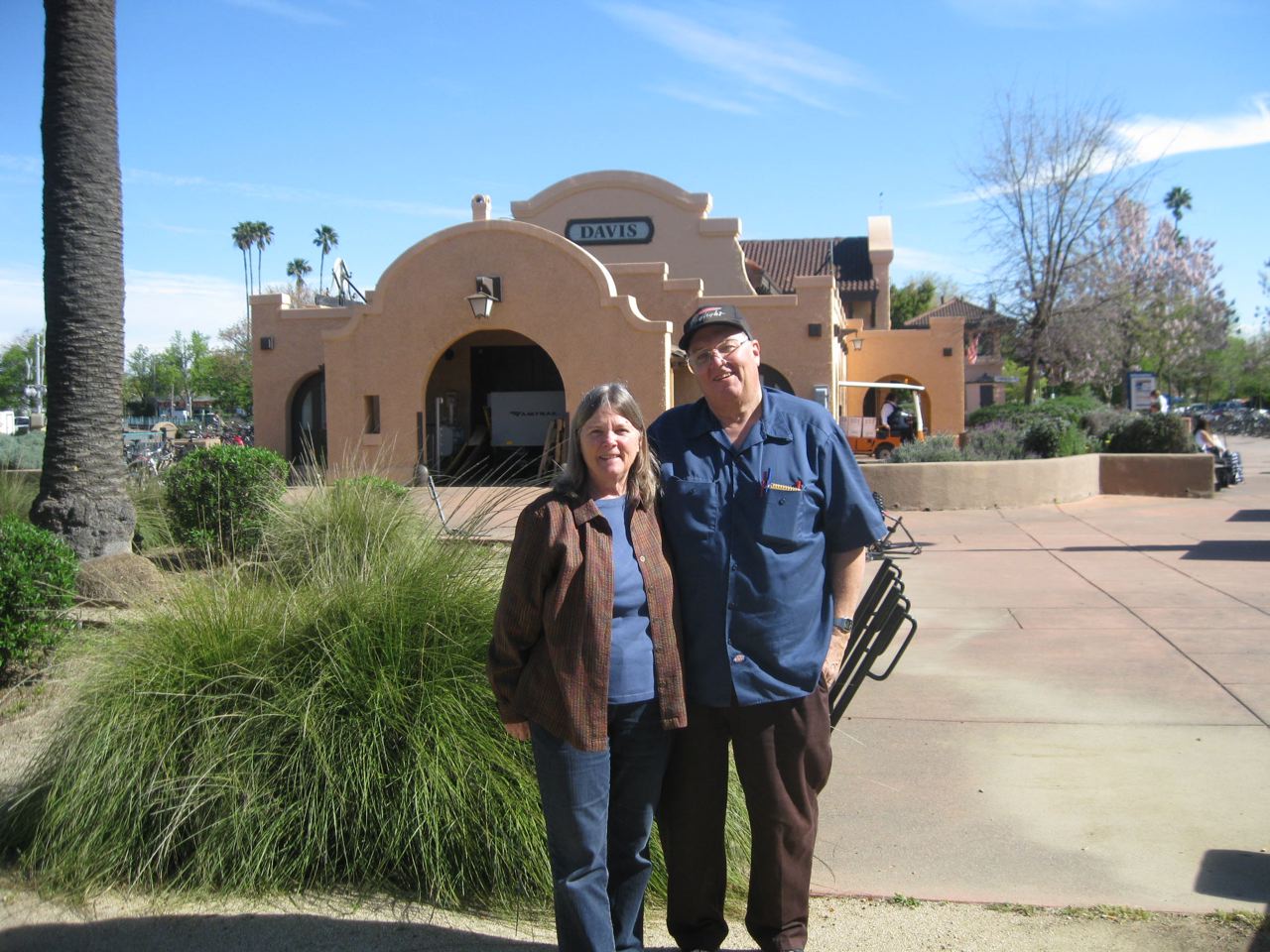 |
| The Zephyr was reported on-time, but first, at 10:25, came Capitol train 535 from Sacramento, with an Amtrak P42, No. 117, instead of the usual Amtrak California F59 in the 2000-series. The first car behind the engine is a former Superliner, repainted, but carrying a 5-digit number. The normal "California cars" have 4-digit numbers. |
 |
 |
 |
| Right on-time at 10:35 comes #6, engines 204 and 87 with 9 cars; my "free" deluxe bedroom is in 32085 Kentucky, the rear car. We left 5 minutes late. |
 |
 |
| Sacramento was a 15-minute leg-stretch, smoke, and rest stop. I had not been thru here since the light-rail spur was built into the depot. |
 |
 |
| During our stop, an eastbound Capitol came in and terminated, again with an Amtrak locomotive. |
 |
| Our car attendant, already "loosened up" by Chuck and Rick, who boarded at the Emeryville point of origin, was one of the best attendants I've ever had. She is Rebecca Kutak of suburban Chicago, a 1-year Amtrak employee with a great attitude and work ethic. She was receptive to Rick's "route charts" with details of the line, brought copies of a rail magazine to us, and was just generally "on the ball." |
 |
| Chuck and I kept our bedroom suite door open in the daytime. Rick had been moved from Roomette 5 upstairs to 11 downstairs owing to a mechanical problem with the upper bunk in 5, so it was easy for him to "escape" from us. |
 |
| Easing into the Roseville station stop, I snapped these units thru our room window at the adjacent diesel shop. |
 |
| The rotary parked in Roseville had recently seen service up on "the Hill" (Donner Pass). |
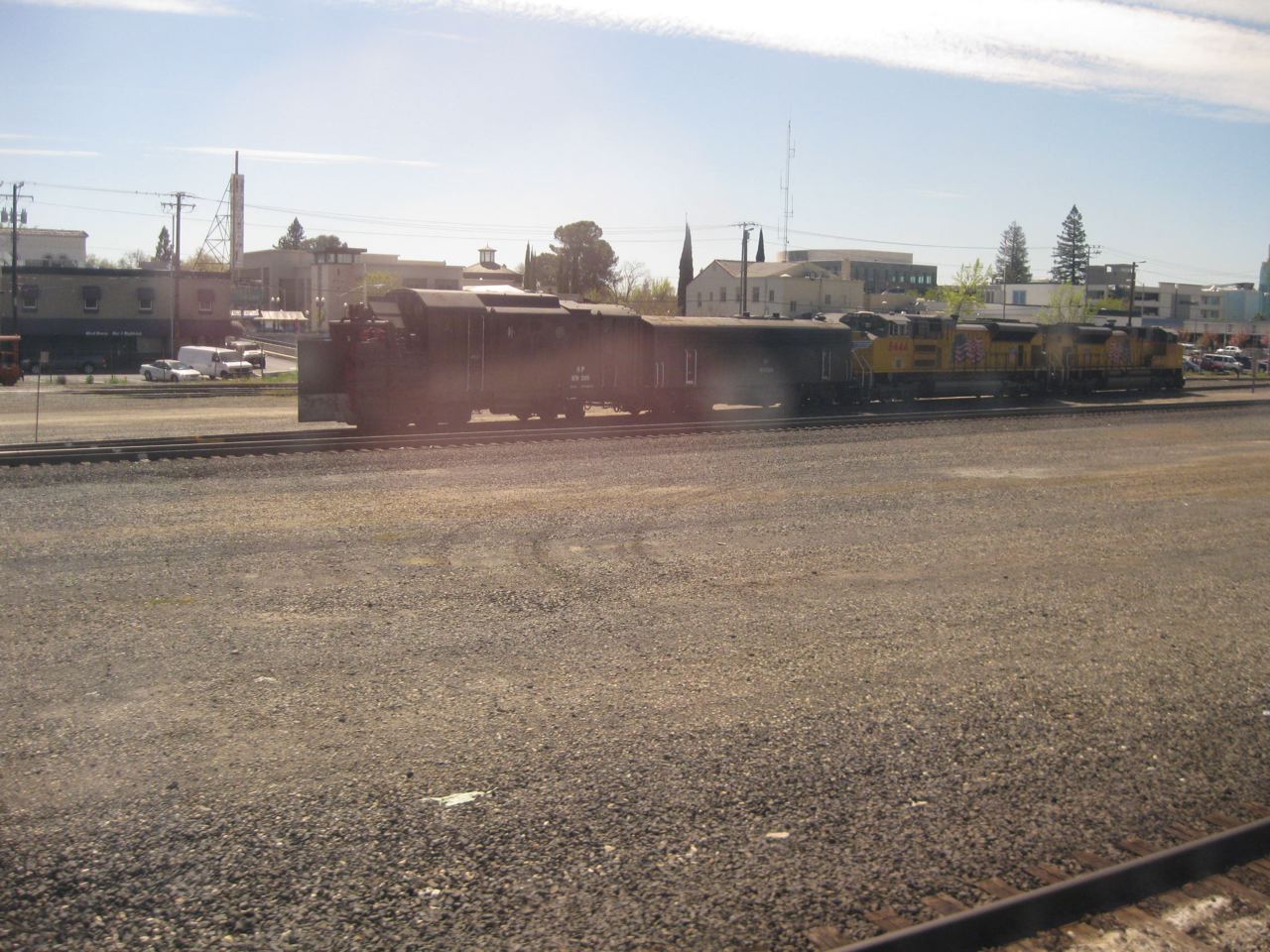 |
| I didn't recall seeing this displayed SP engine last time I was in Roseville in the auto. |
 |
| The window on the back vestibule door of our sleeper began the trip fairly clean; this is east of Auburn beginning our climb into the hills; the window would not stay clean for the 2,445-mile trip! |
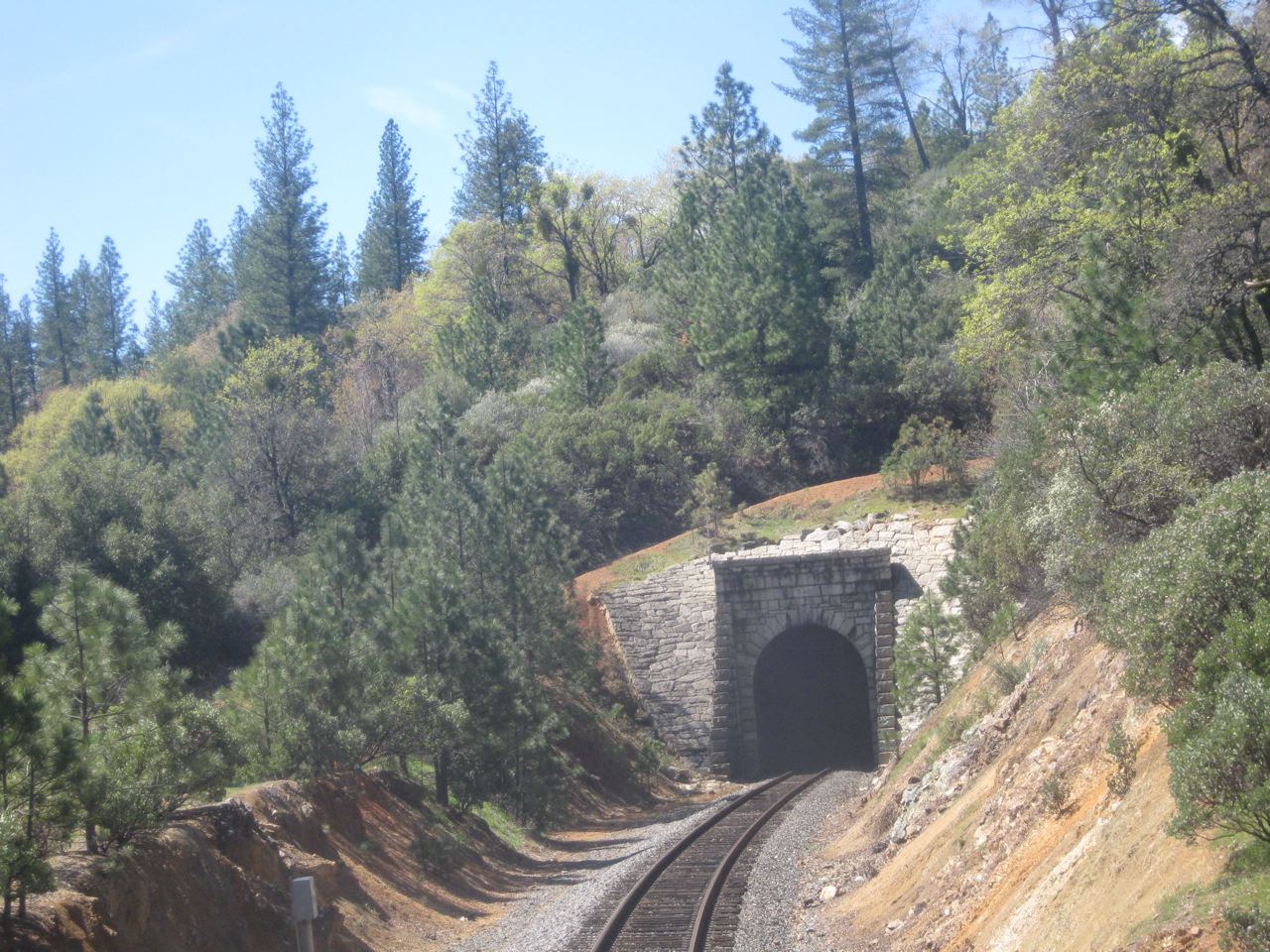 |
| Donner Pass had some record snows this winter and there was still plenty of it on the ground. These photos are from either our sleeper, thru the side or rear windows, or the Sightseer Lounge, where we went and found a table after lunch. |
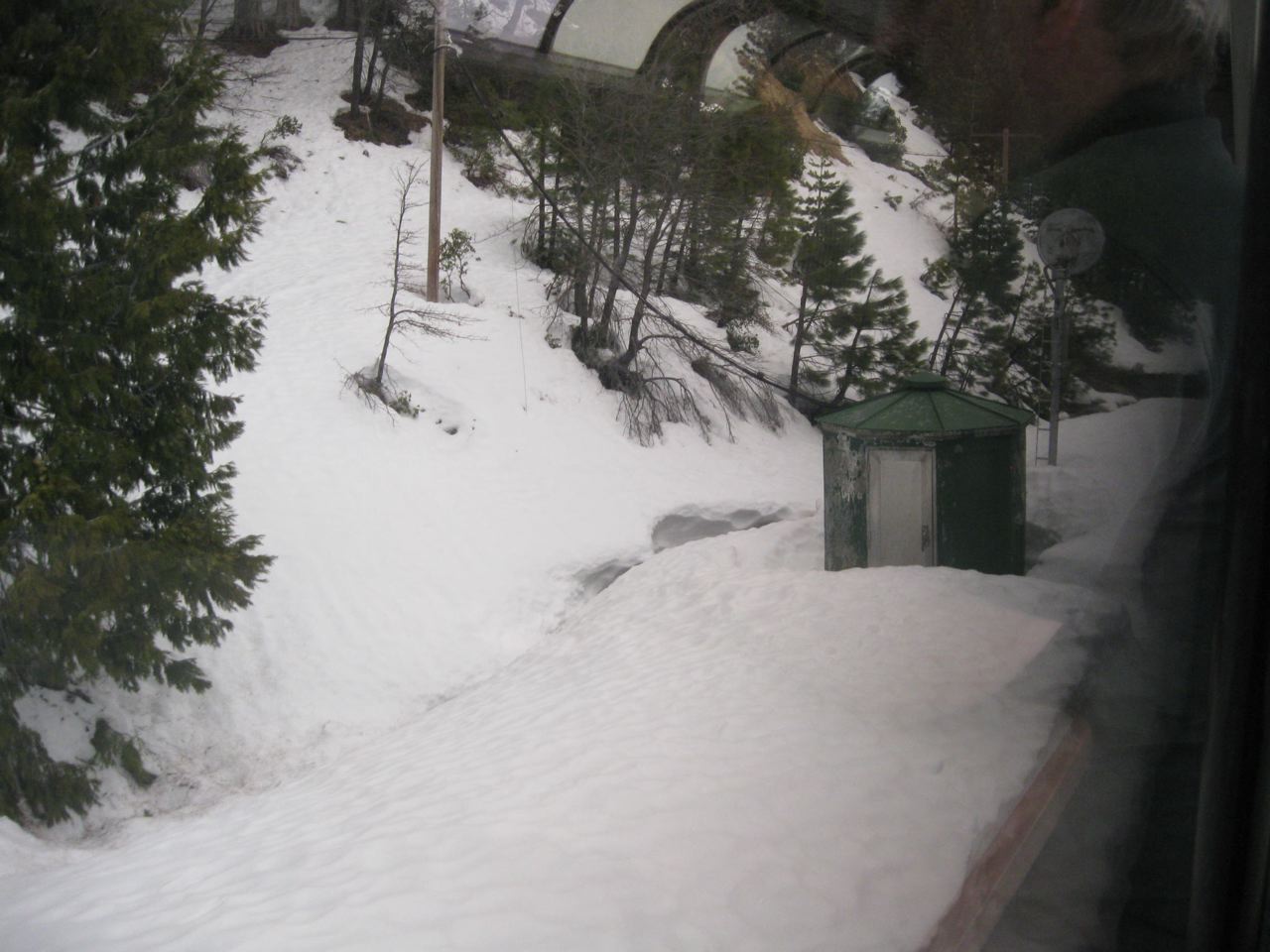 |
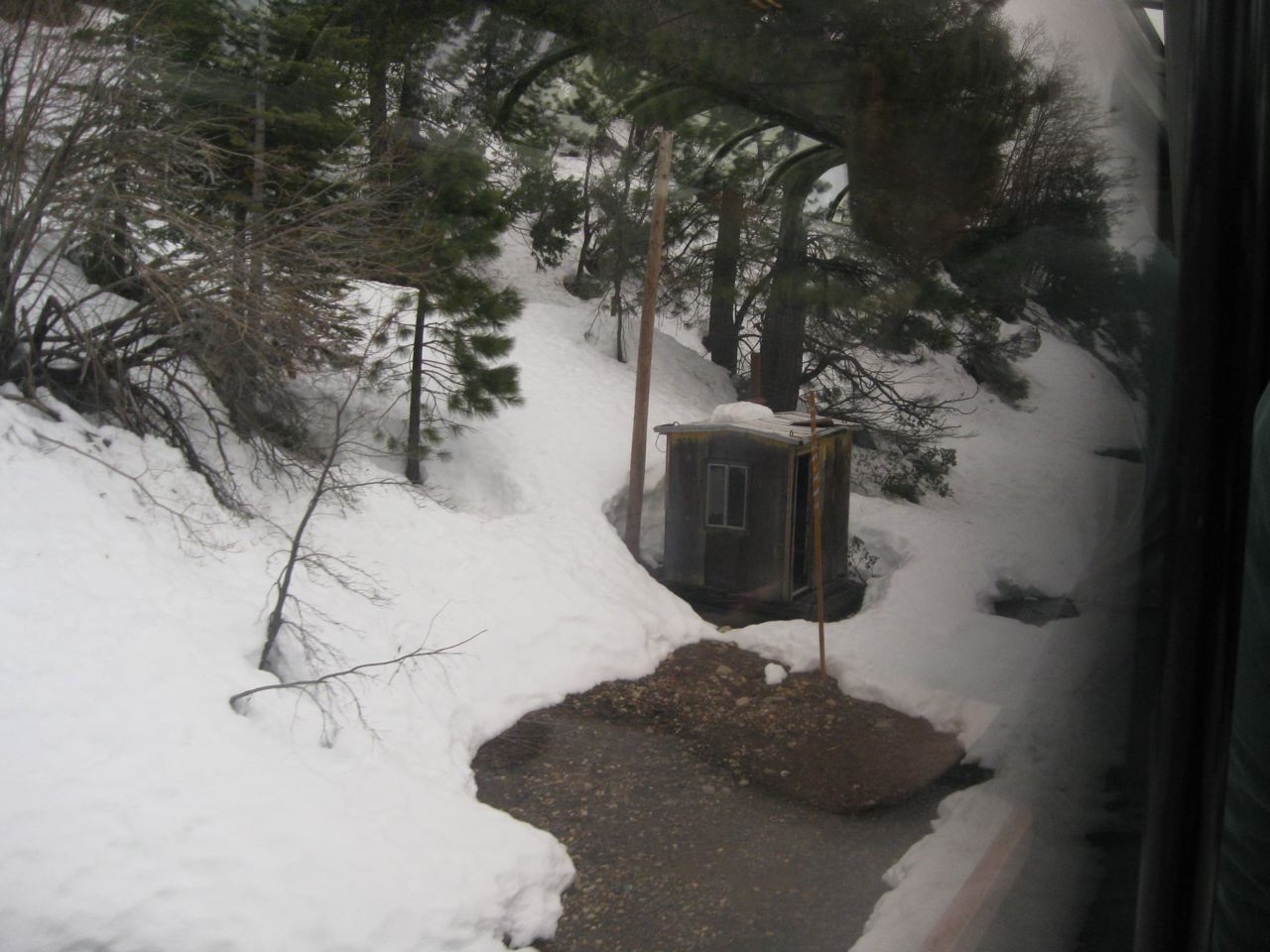 |
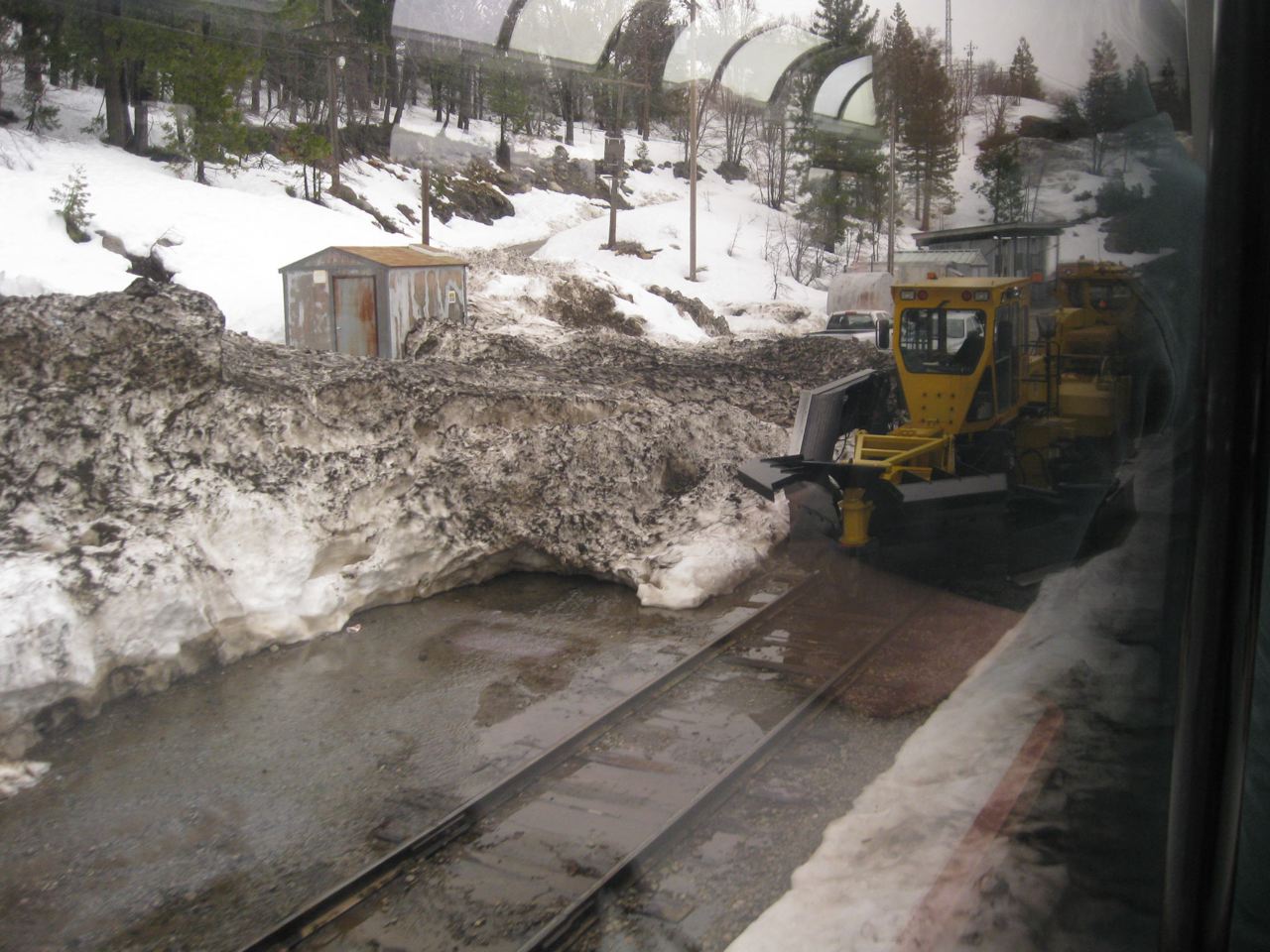 |
 |
 |
 |
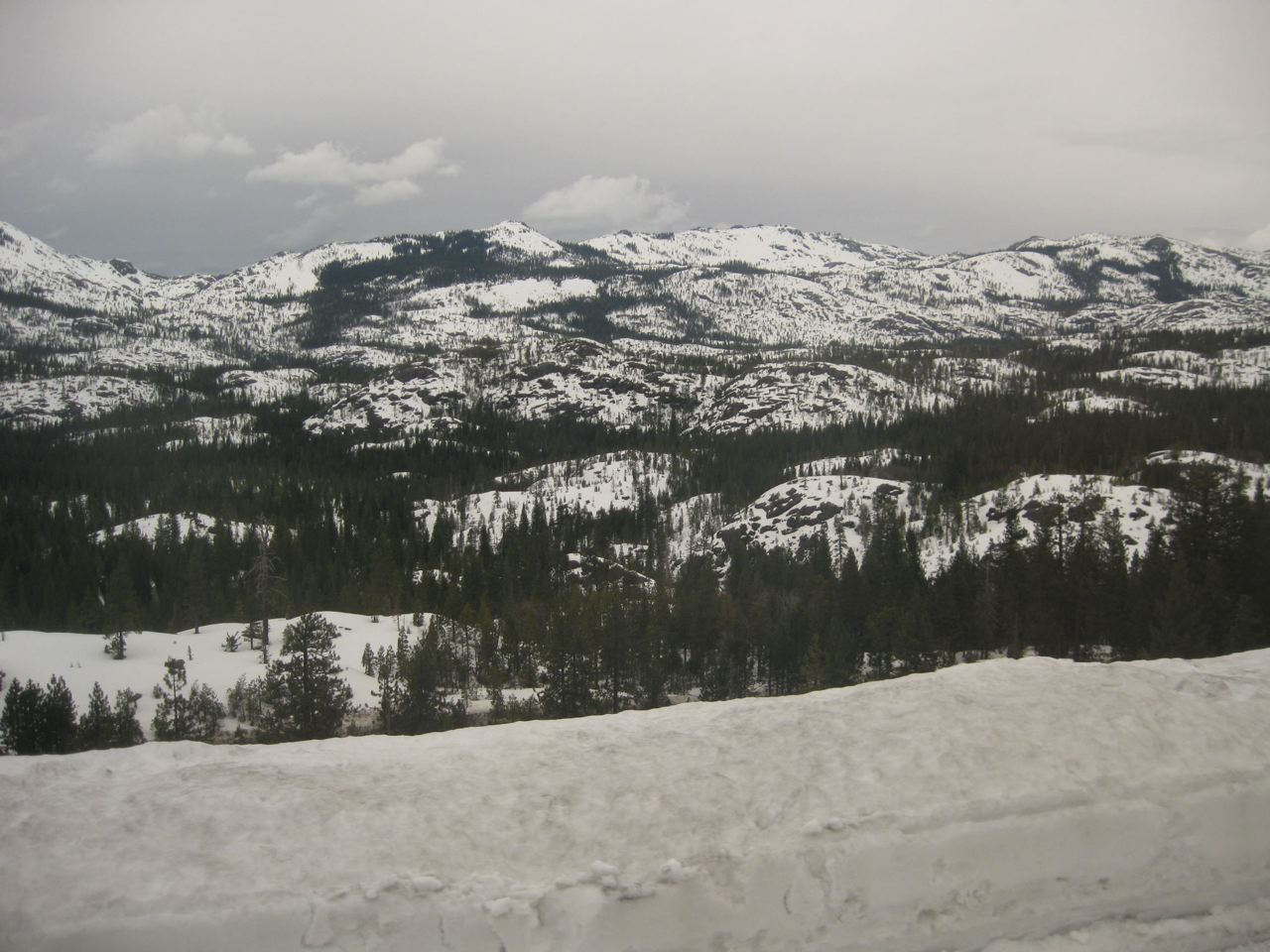 |
 |
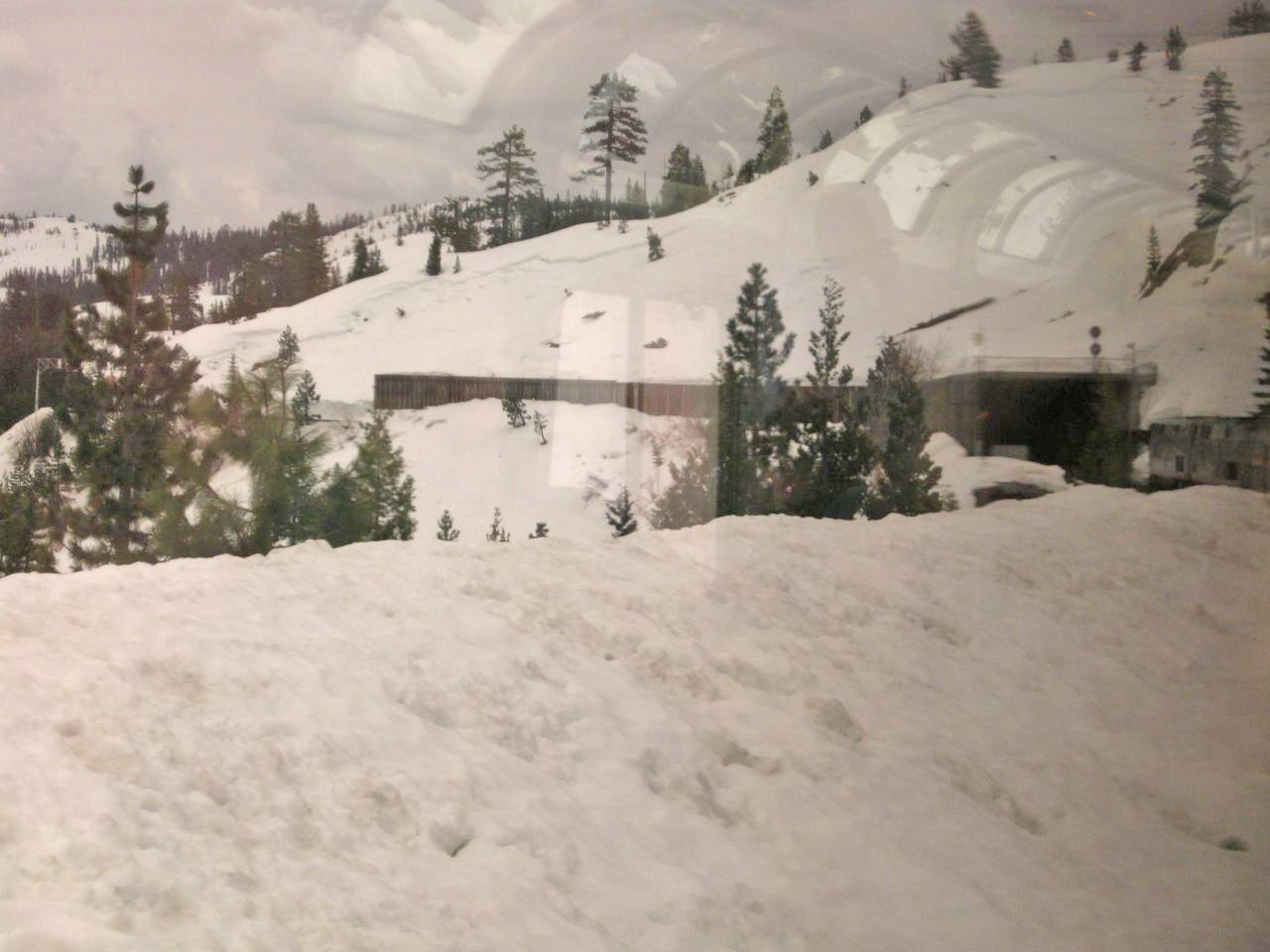 |
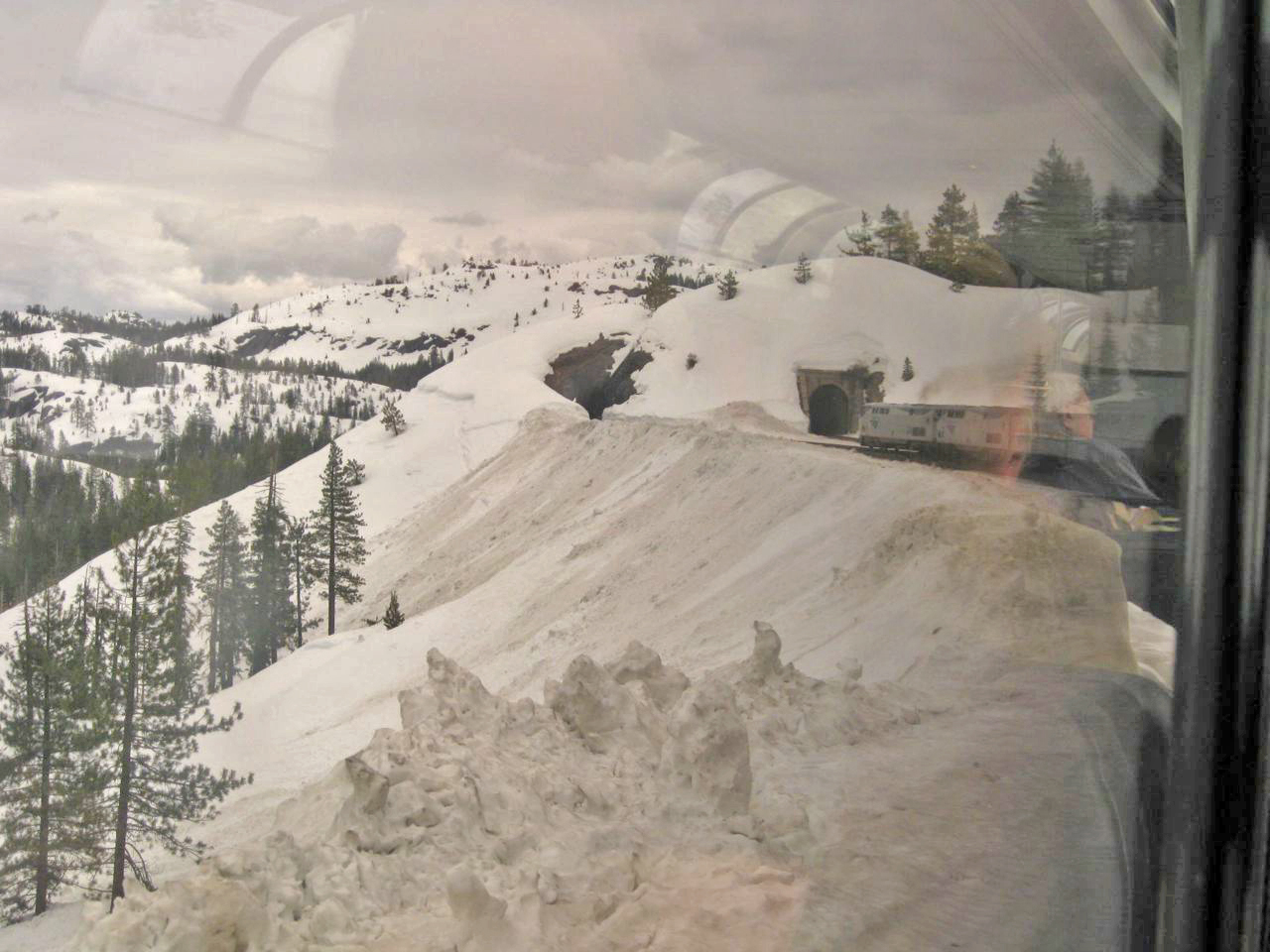 |
 |
 |
 |
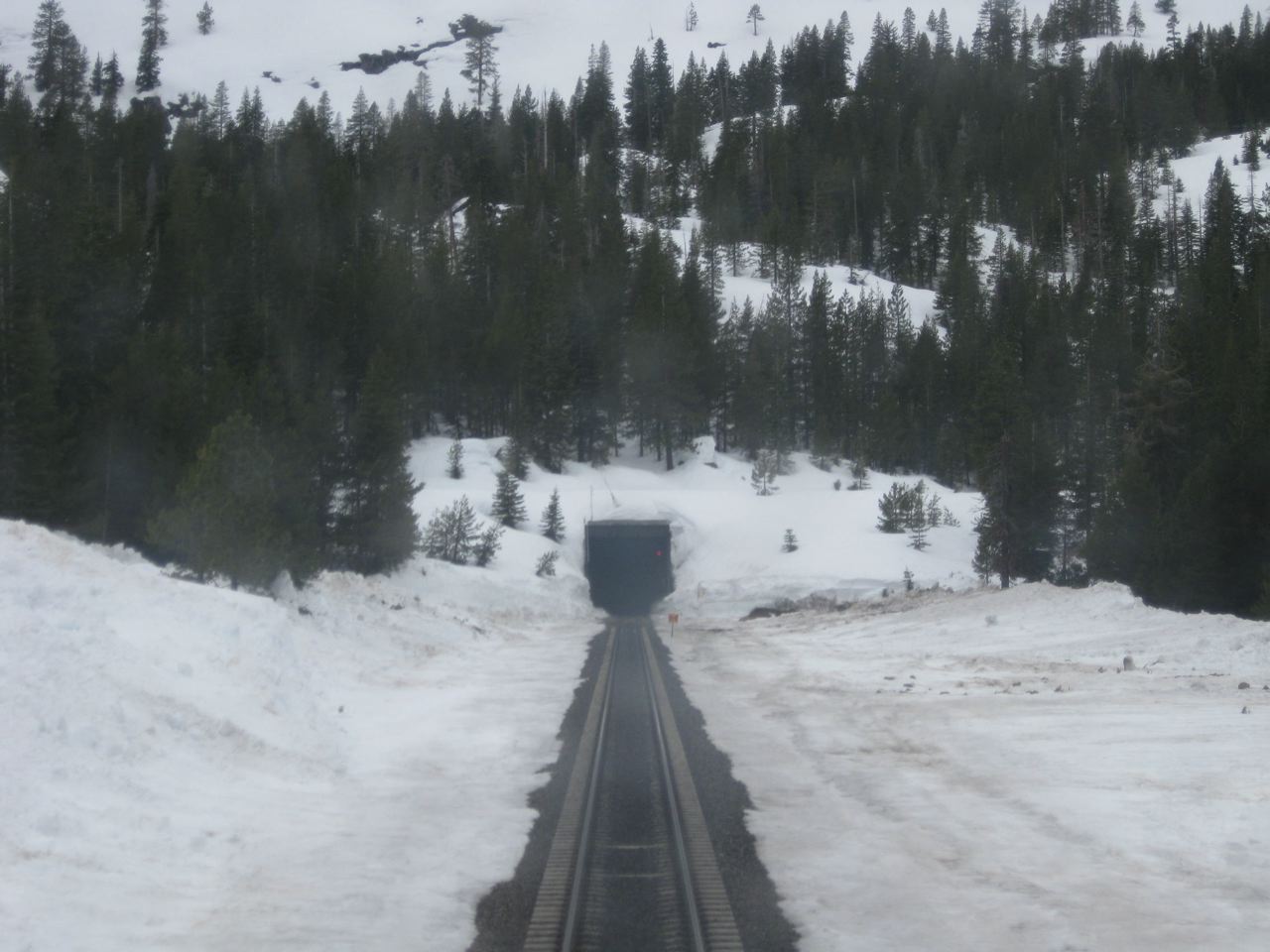 |
 |
 |
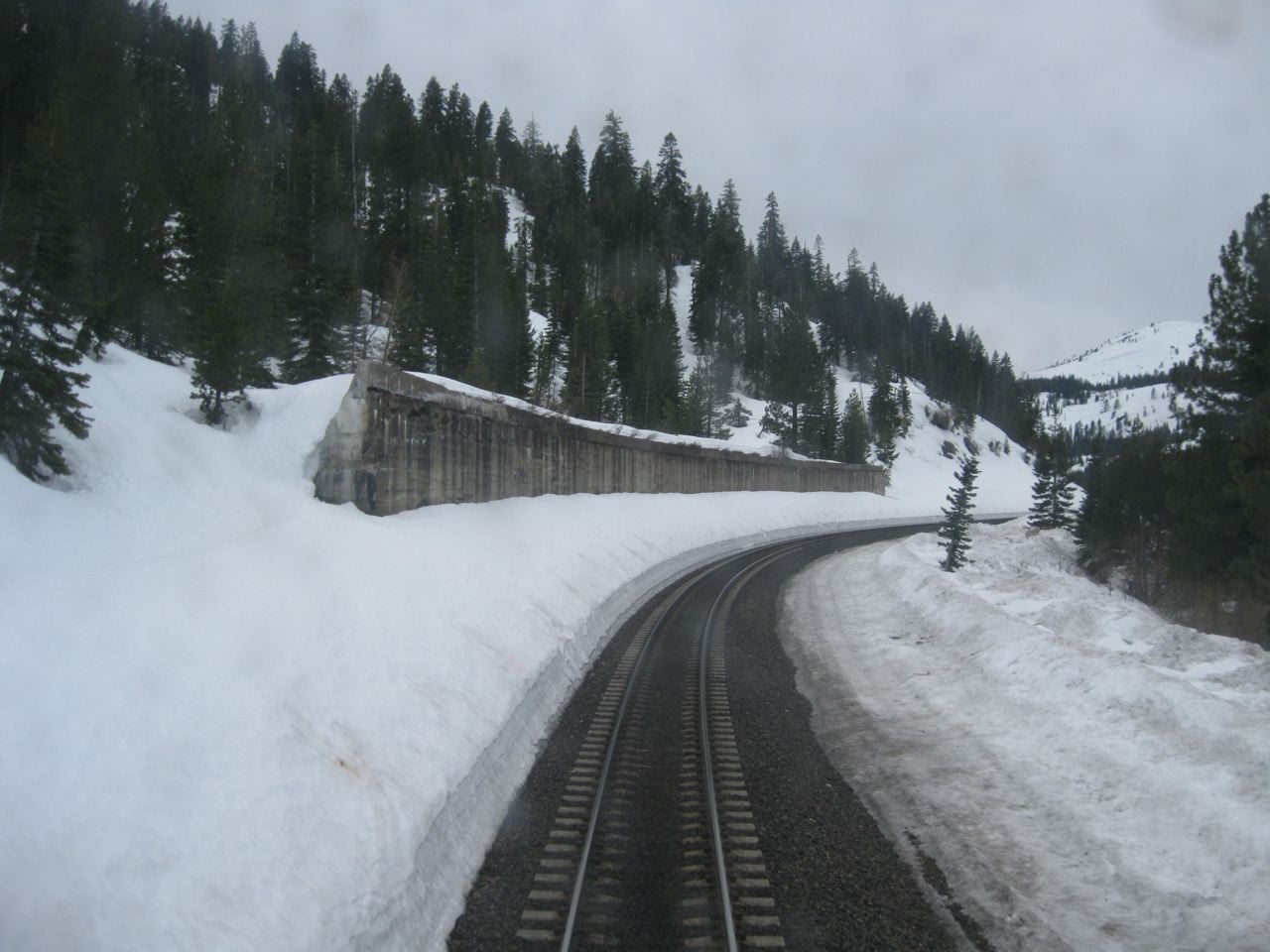 |
| We left Truckee 18 minutes late just before 3 pm PDT, saw our first train just east of Truckee, parked, waiting for us to clear the single open track. I believe we were only the third #6 to go over Donner after the closures during the snowplowing operations. |
 |
 |
| Down toward the Nevada state line, the snow was behind us, the sun came out, and the sky to the east and southeast looked threatening. |
 |
| This would be my first trip thru UP's "Reno trench," although I photographed #5 leaving the depot on our August 2009 drive from home to Santa Rosa. |
 |
 |
| Our Reno station stop was 16 minutes, with departure 8 minutes off schedule. |
 |
| I thought we'd finally go right thru Sparks without stopping, as it's no longer a stop for the Zephyr (since the Reno stop no longer blocks grade crossings -- Reno is now the smoke/rest/leg-stretch stop), but no, we stopped to pick up several UP freight crews deadheading east! |
 |
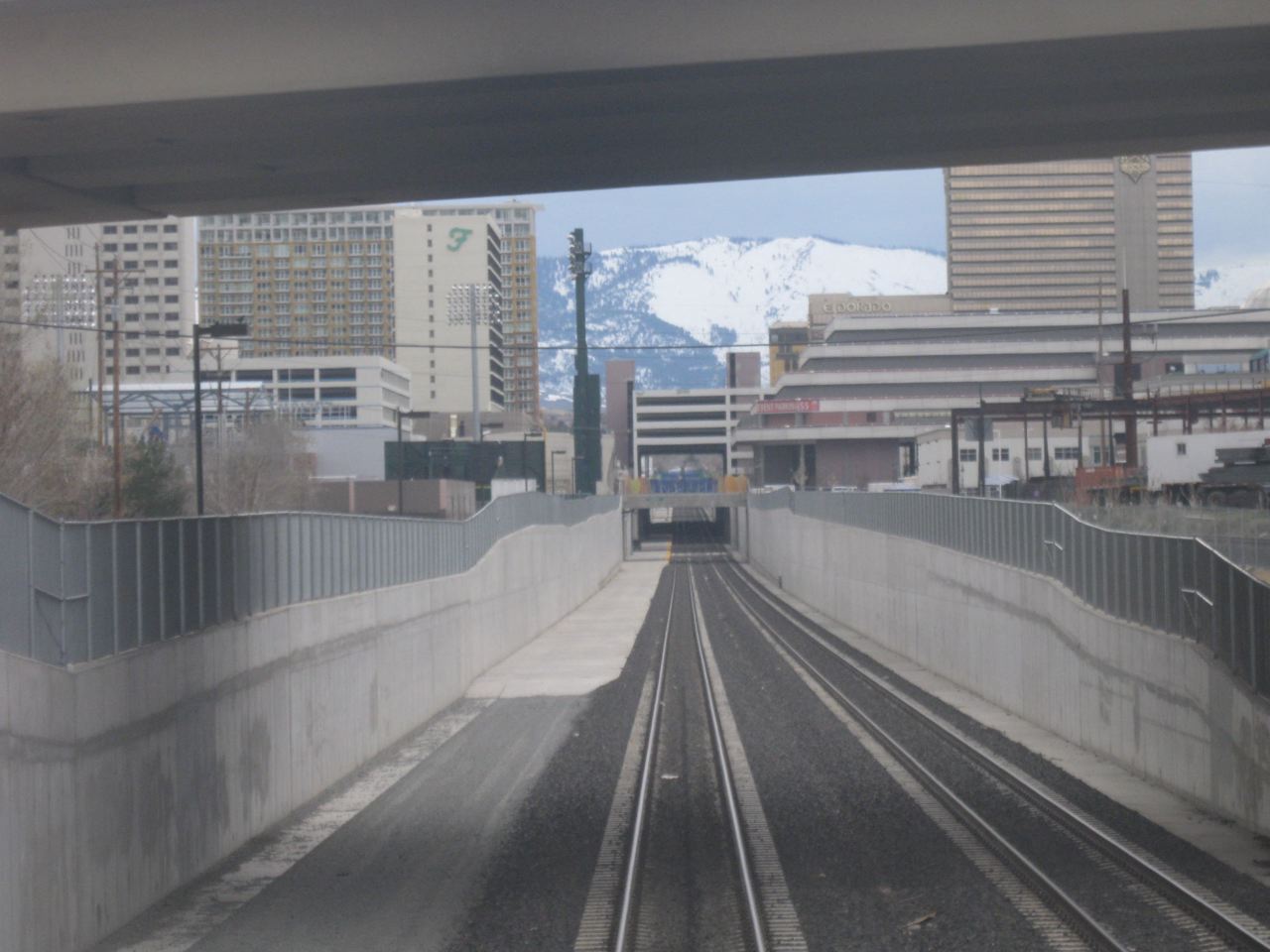 |
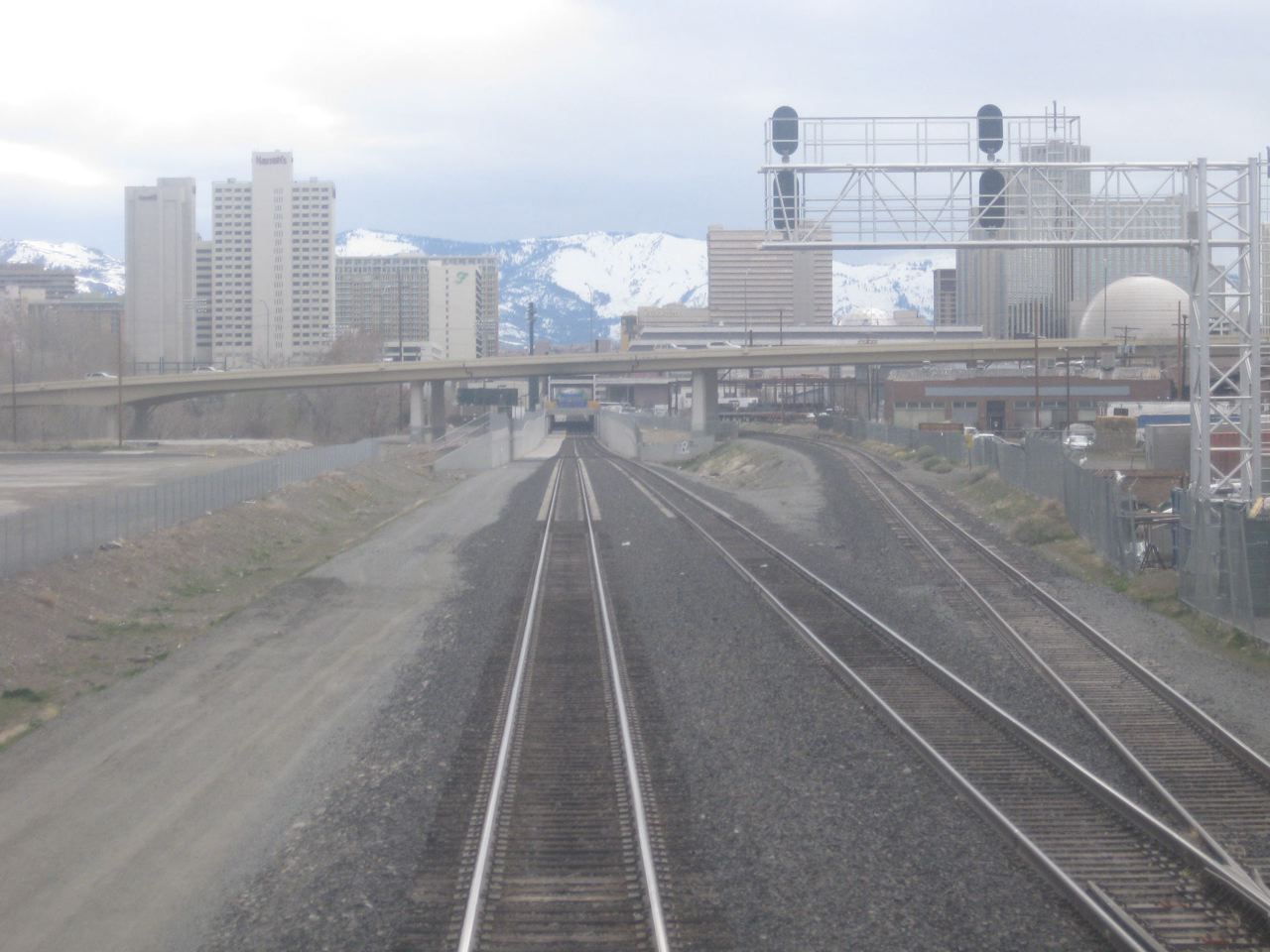 |
| Leaving Sparks, we passed a BNSF trackage-rights train. |
 |
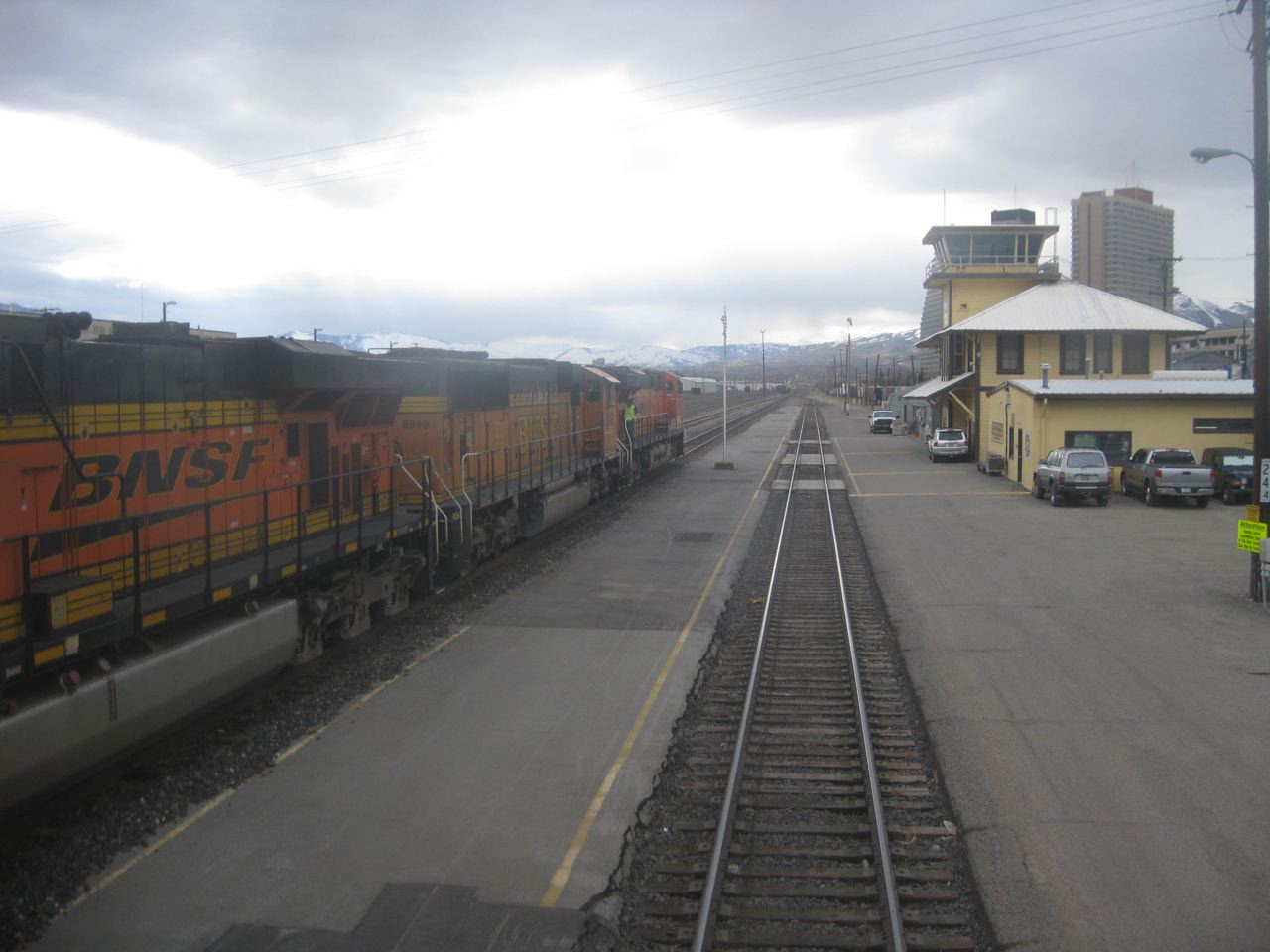 |
| Then east of Sparks we passed a short, westbound BNSF local. BNSF must be hustling good local business; they keep switchers stationed at Reno and Grand Jct., Colo., and have a contact firm do the local work in Salt Lake City, all trackage and local-business rights gained in the UP-SP merger. |
 |
| In 2009 we overnighted in each direction in Fernley, but I couldn't resist a "from the train" view of its preserved, relocated, and apparently privately owned ex-SP depot, since it has a small collection of equipment around it. |
 |
| A windstorm was kicking up sand on the big, dry Carson Sink. |
 |
| The Sightseer Lounge was comfortably not real full; more passengers disembarked at Reno than boarded. We had a pleasant late afternoon ride across the western Nevada desert, usually within sight of I-80. The sun went down during our Winnemucca stop, when we were in the diner, and trees and a mountain obscured a nice, anticipated sunset shot. |
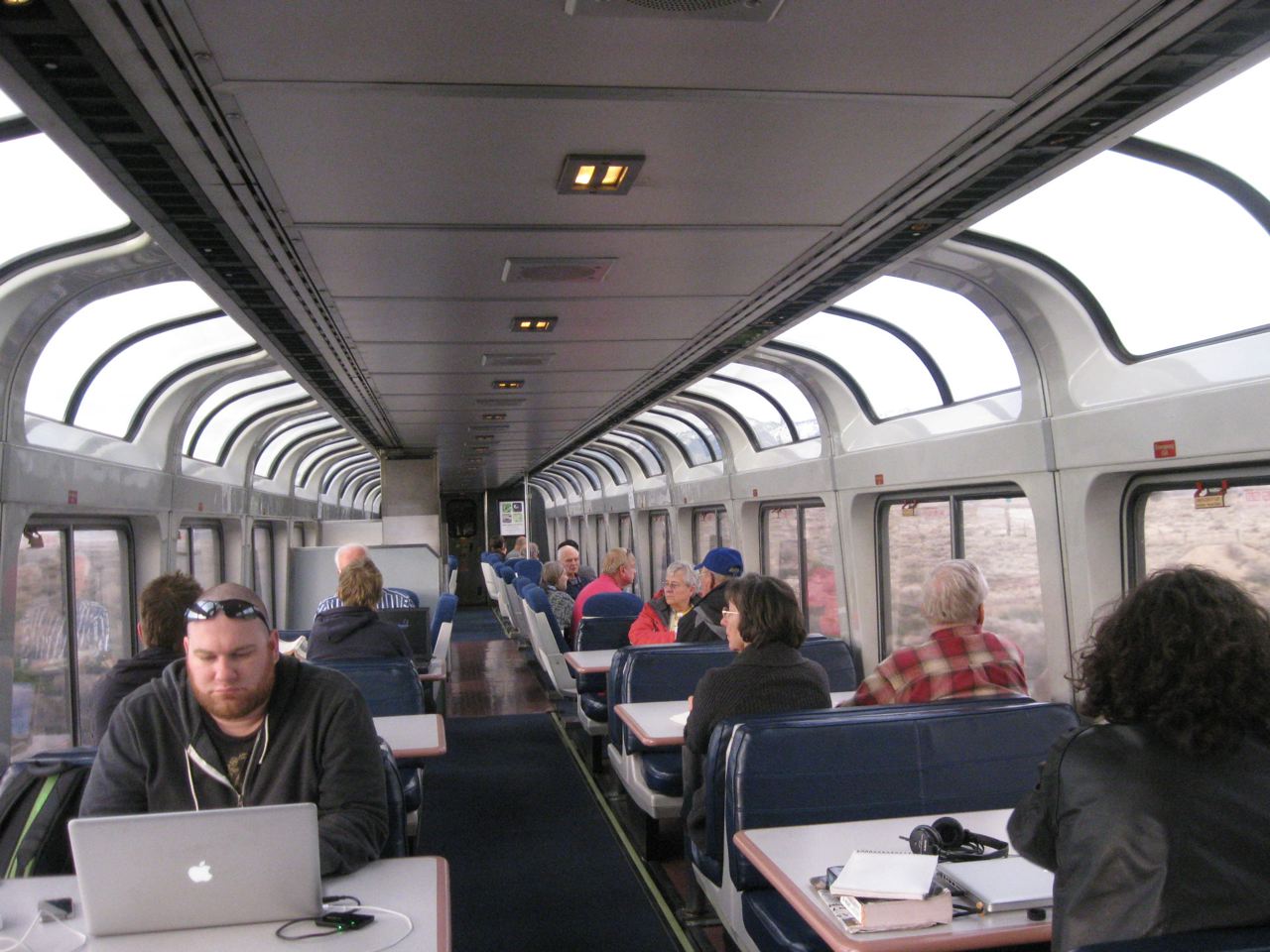 |
 |
| Eavesdropping on our conductor, we could tell he was a bit of a local historian and seemingly a railfan. |
 |
| The last shots made were just west of Winnemucca, where our crew-change stop (there is no depot, just a shelter; UP has a real building over on the ex-WP side of town) was 12 minutes before we left, on-time, at 708 pm PDT. |
 |
 |
| Retiring at Elko well after dark, I slept thru Salt Lake (315-330 a.m., out on-time, I later learned) and Provo (19 minutes late) and woke up as we left Helper, Utah, during our 1-minute stop at 7 a.m. MDT. At our Green River stop at 8:15, 16 minutes late, we were at breakfast and could not photograph yet another westbound BNSF trackage-rights freight. The first photos of the day were made way east of there in the Ruby Canyon area near the Utah-Colorado state line. |
 |
 |
 |
 |
| Grand Junction was a 25-minute service, rest, crew-change, and smoke stop. |
 |
| Amtrak occupies for its station what i think may be the old baggage and express building. |
 |
| The old D&RGW depot is fenced off, apparently undergoing some type of restoration. |
 |
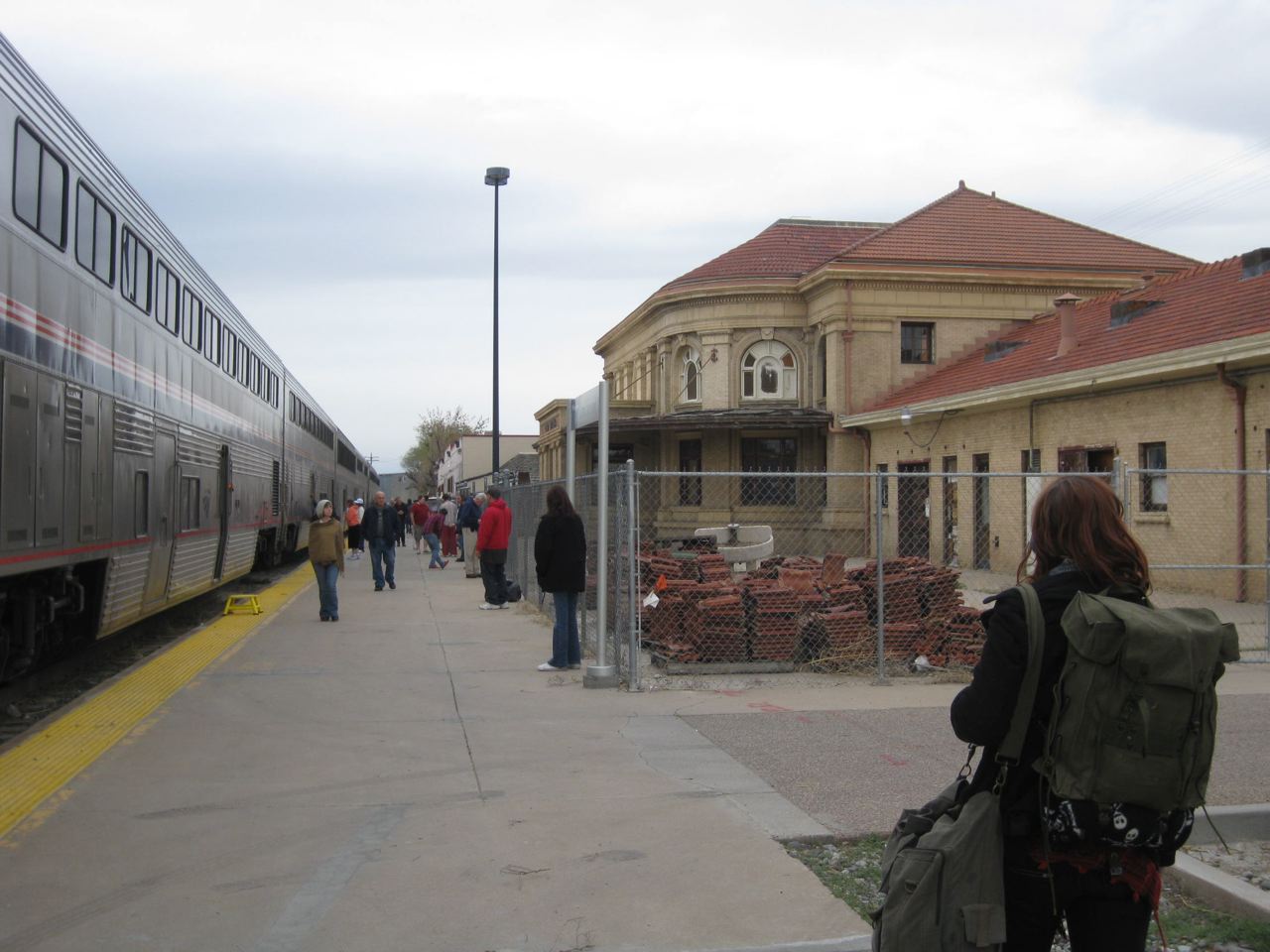 |
| The easternmost building is a newish replica building housing private businesses. |
 |
| Under its trackside awning is this historic sign from another building. |
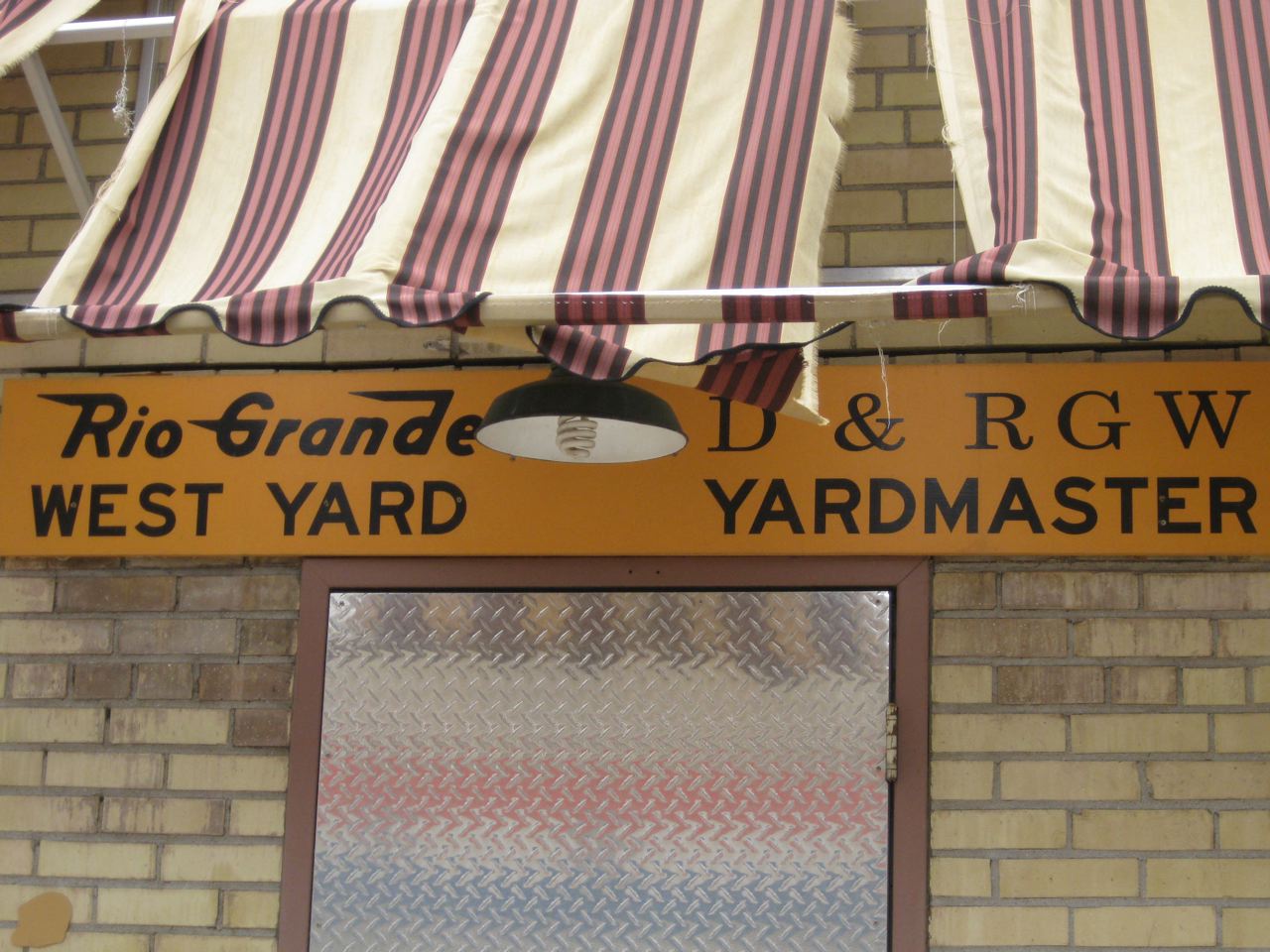 |
| These two-pole signs seem to have taken the place of the tall, more solid and curved, station signs Amtrak had been installing everywhere. |
 |
| As we left the station, we passed the local BNSF switcher's caboose, bearing no markings for BNSF, just the old BN identification. |
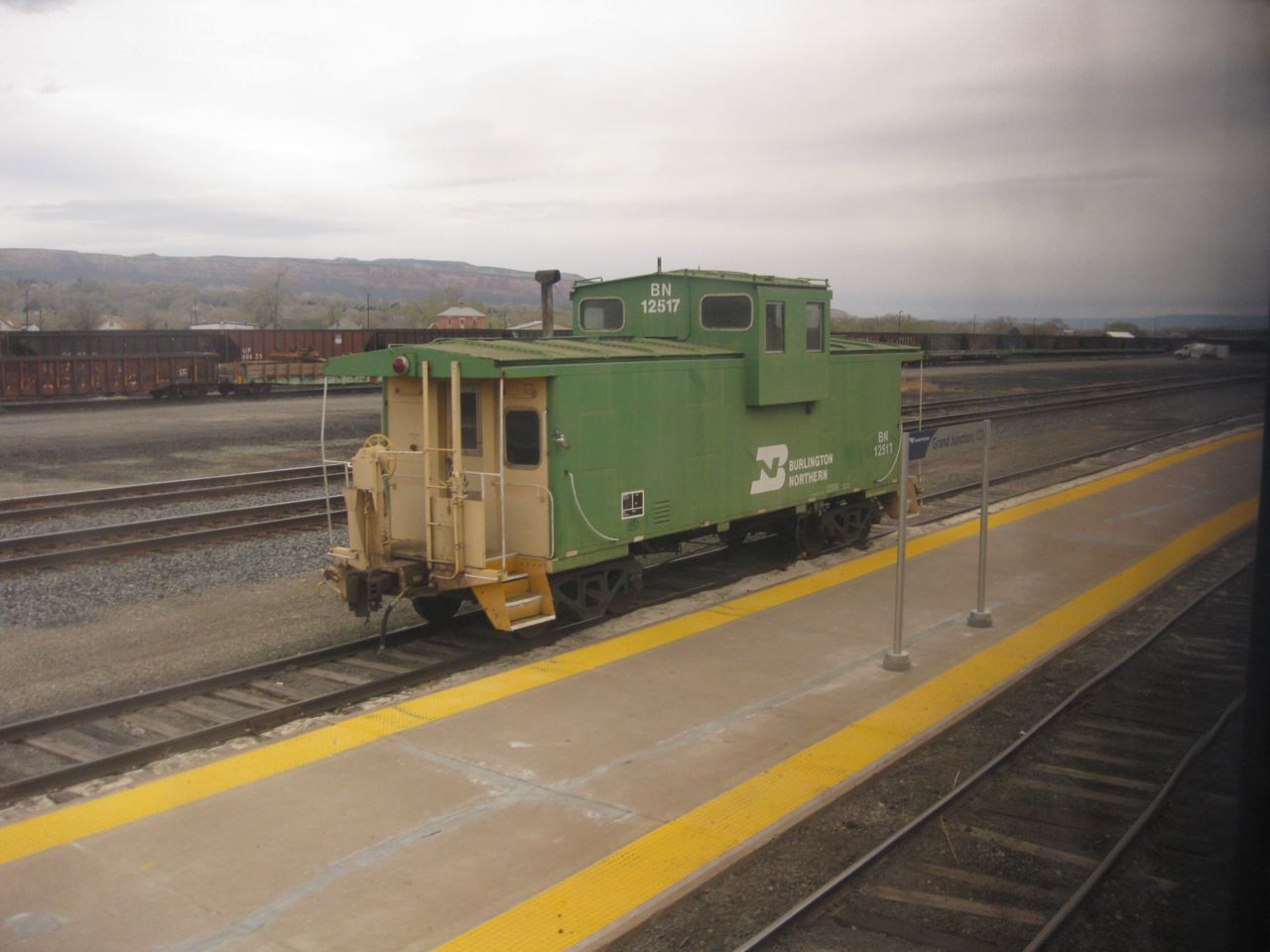 |
| UP's yard swticher was this SP neatly "patched" GP40. |
 |
| Grand Mesa had a lot of snow cover. We'd see much more! |
 |
| The old road bridge at Rifle over the Colorado River has stood the test of time -- I remember our family driving over it on a mid-1950's vacation! |
 |
| Coming into Glenwood Springs we passed a long line of stored power in the yard, well more than a dozen units. The current main line uses a few miles of original Colorado Midland right of way west of Glenwood here; CM was a standard-gauge road from early in the 20th century, from Colorado Springs to I think Grand Jct. The Midland Terminal from "the Springs" to Cripple Creek, which lasted into the 1940's I think, was the last remnant to operate. The old O-gauge club in Denver Union Station used the CM as its pike name, and I remember from 50 years ago All-Nation F units decorated for Colorado Midland --- what might have been. |
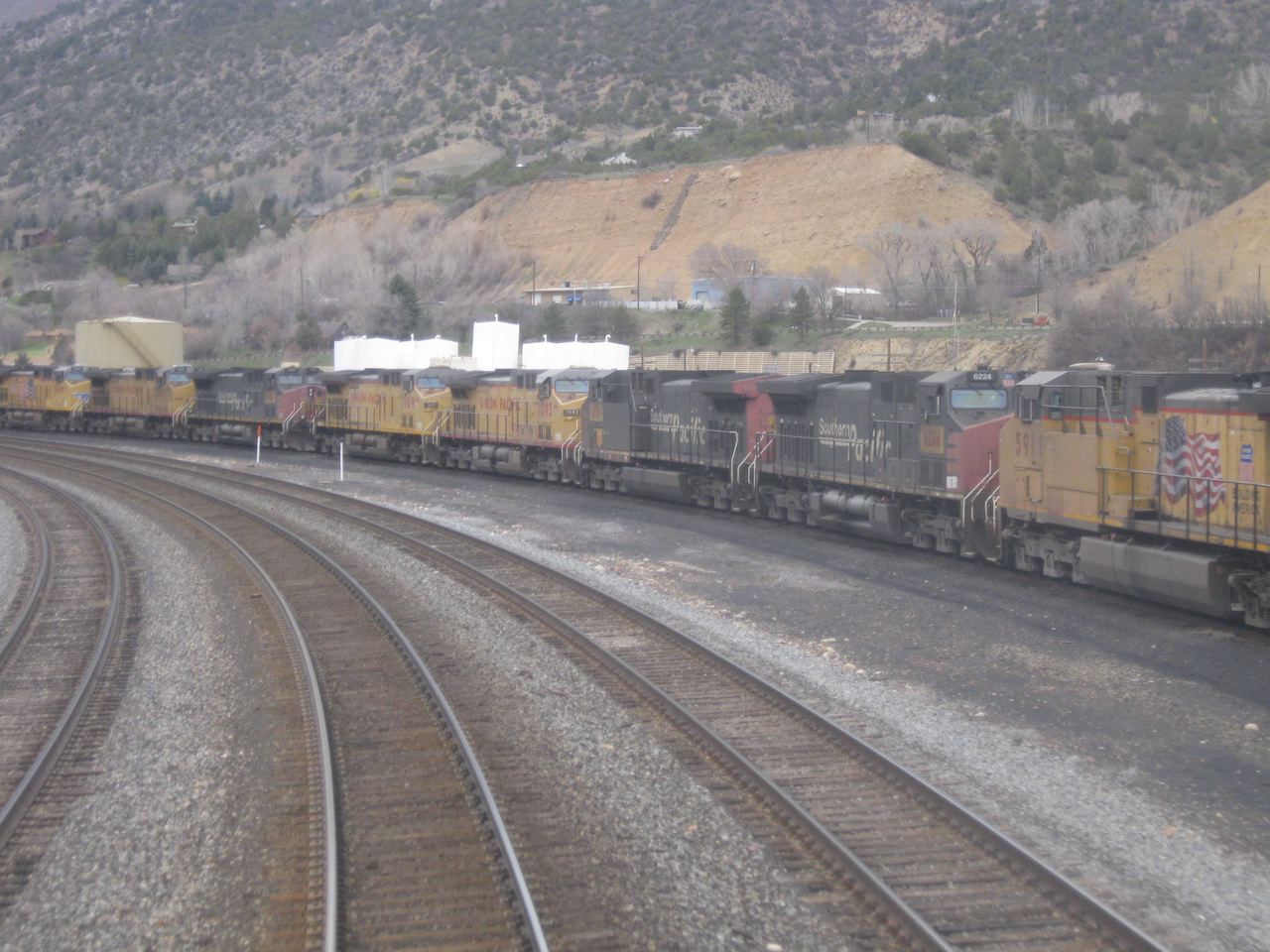 |
 |
| We had a short 9-minute stop at Glenwood Springs. |
 |
| I-70 thru Glenwood Canyon was one of the most expensive, and controversial, stretches of Interstate when it was built. |
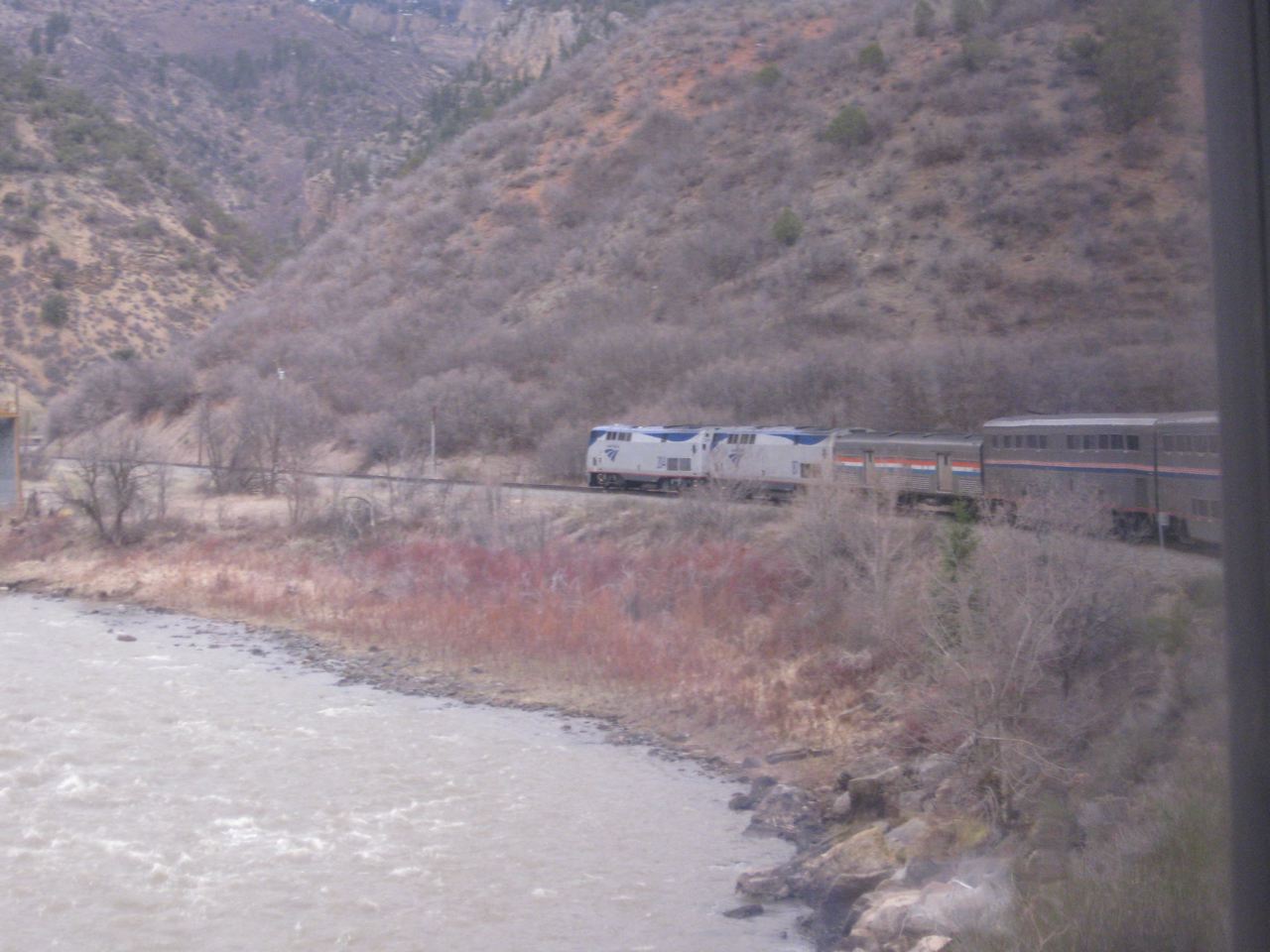 |
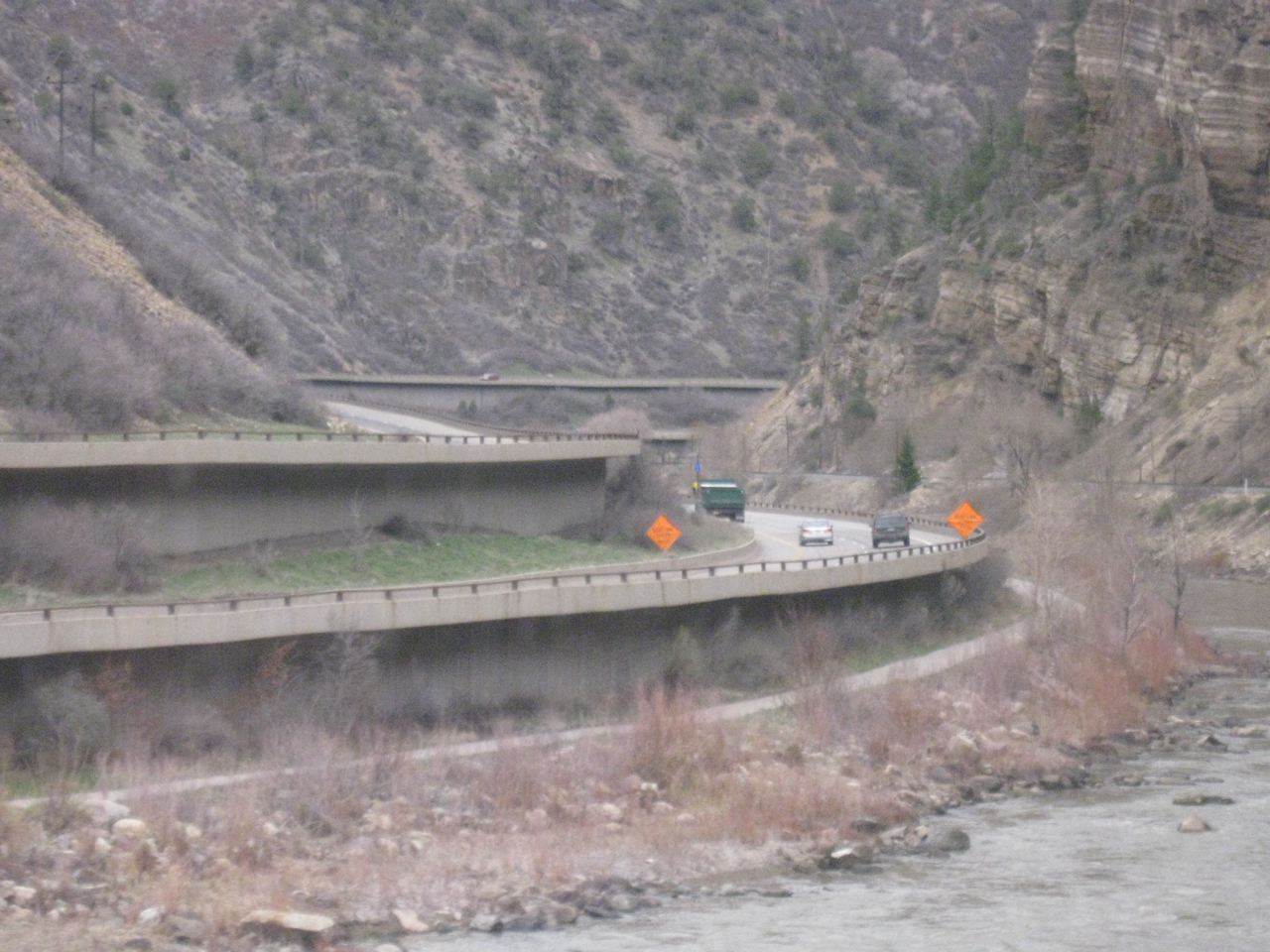 |
 |
 |
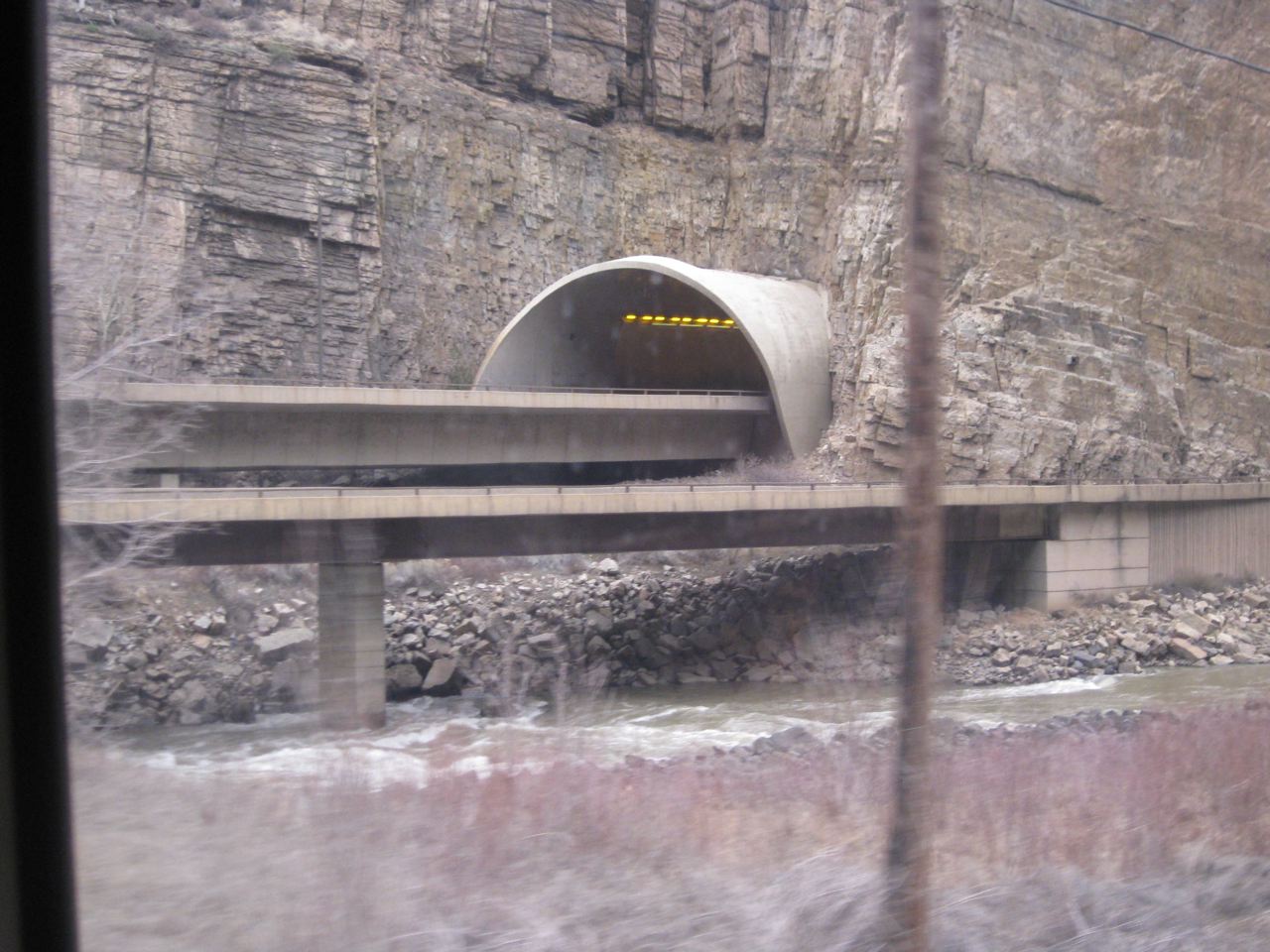 |
| We passed #5 at Range Siding at speed at 1:08 pm but a slide came first and this telephoto view thru our back window isn't super-sharp. |
 |
| As we got into canyon country, you'll see how as we climbed higher the snow got closer until we were in flurries. Sadly, we did not see the sun all day on this scenic ride. |
 |
| Looking back at the tunnel just west of Bond, where the Craig Branch, a coal line now but originally the Denver & Salt Lake, joins our Moffat main. It's 1:45 p.m. |
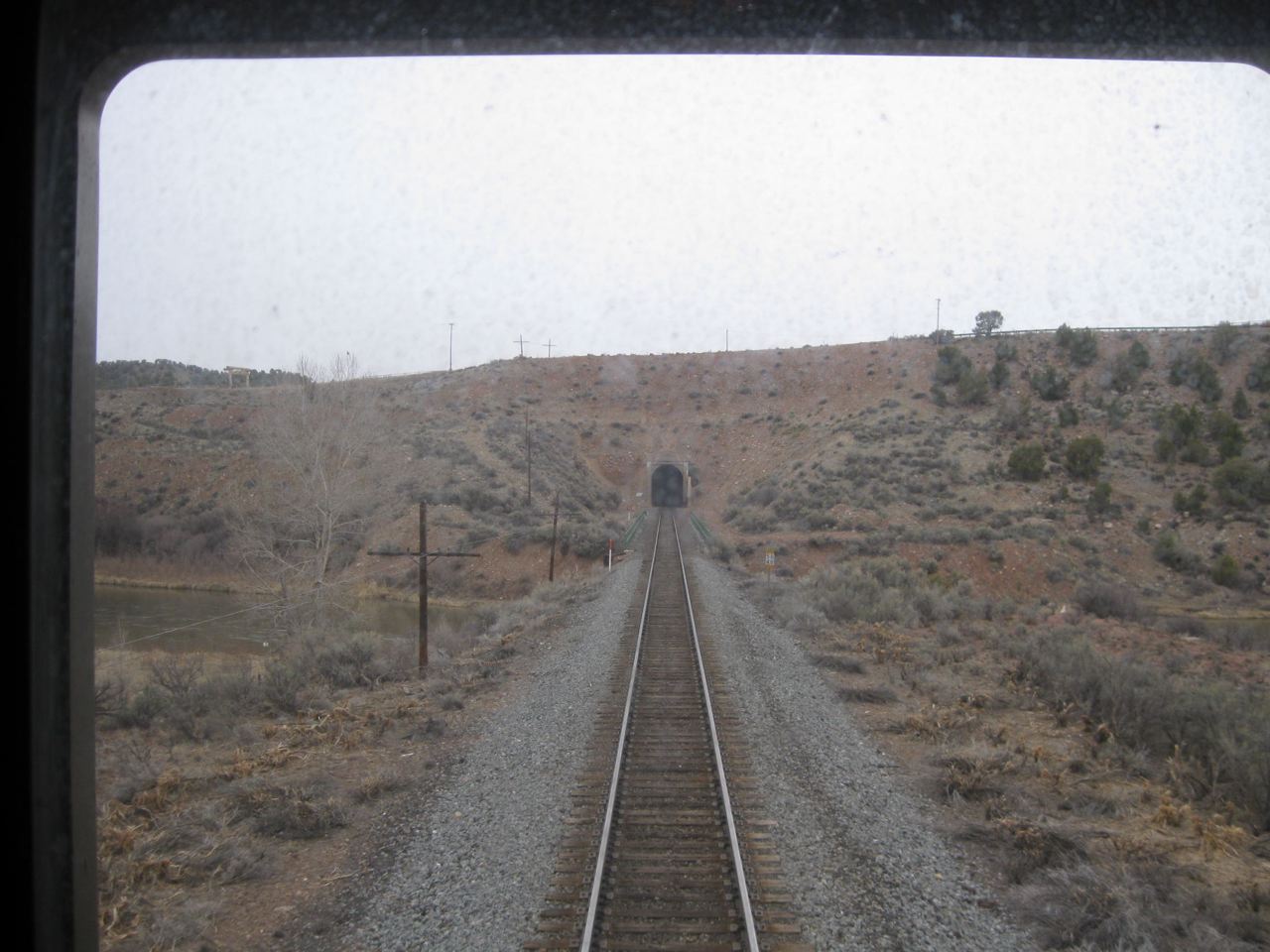 |
| The junction east of Bond, which is around the curve in the distance, is where the old D&SL joins the main. |
 |
| The "fog" you think you see it actually light snow. We are going upstream and climbing, and the engines are smoking it up. |
 |
 |
 |
 |
| One of the many raft launch sites on this stretch of the Colorado, very popular for rafting downstream. We didn't see any -- way too early in the season. |
 |
| Soon we'll be IN the snow. | ||
 |
||
 |
||
 |
||
 |
||
|
||
 |
||
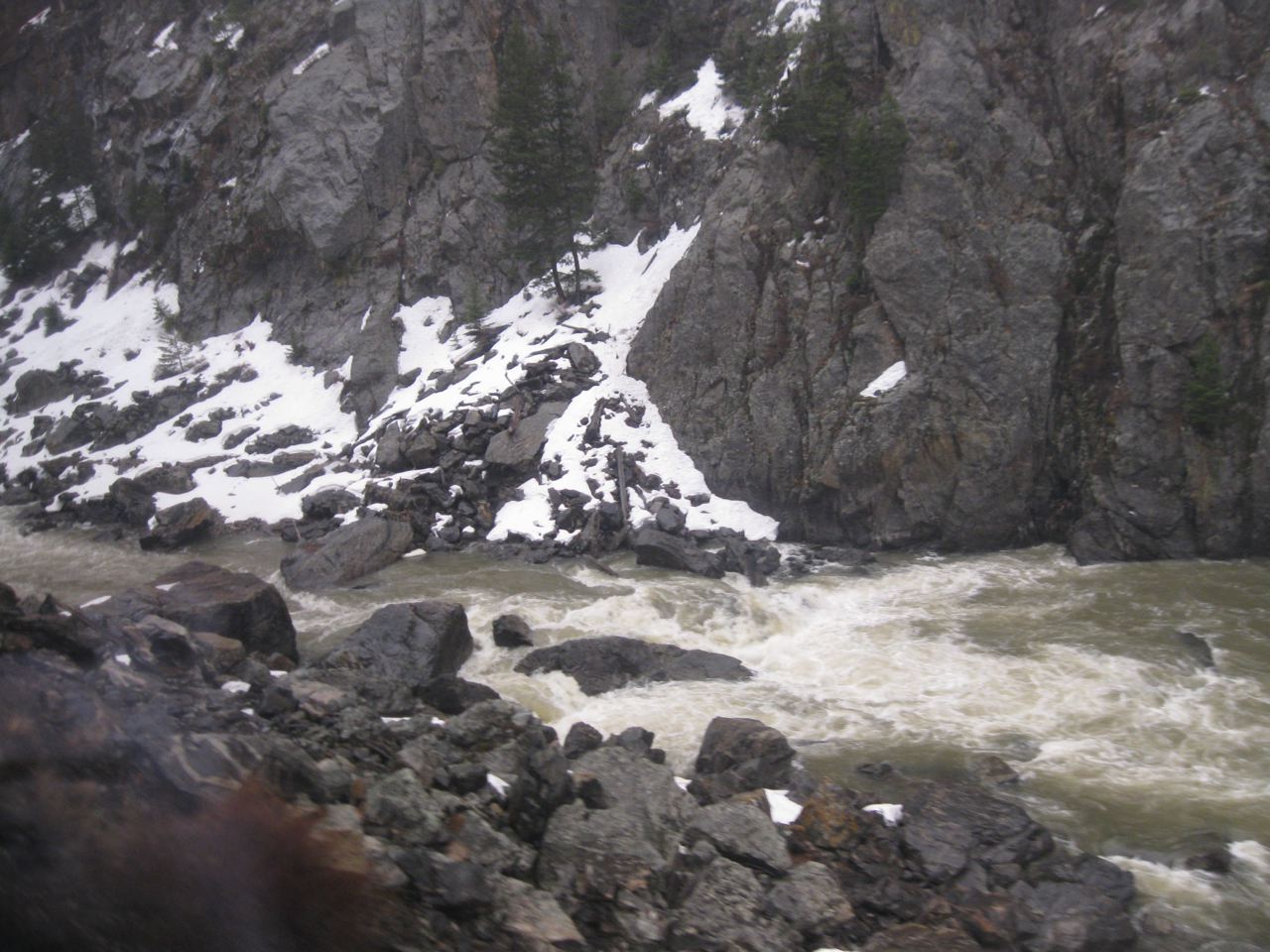 |
||
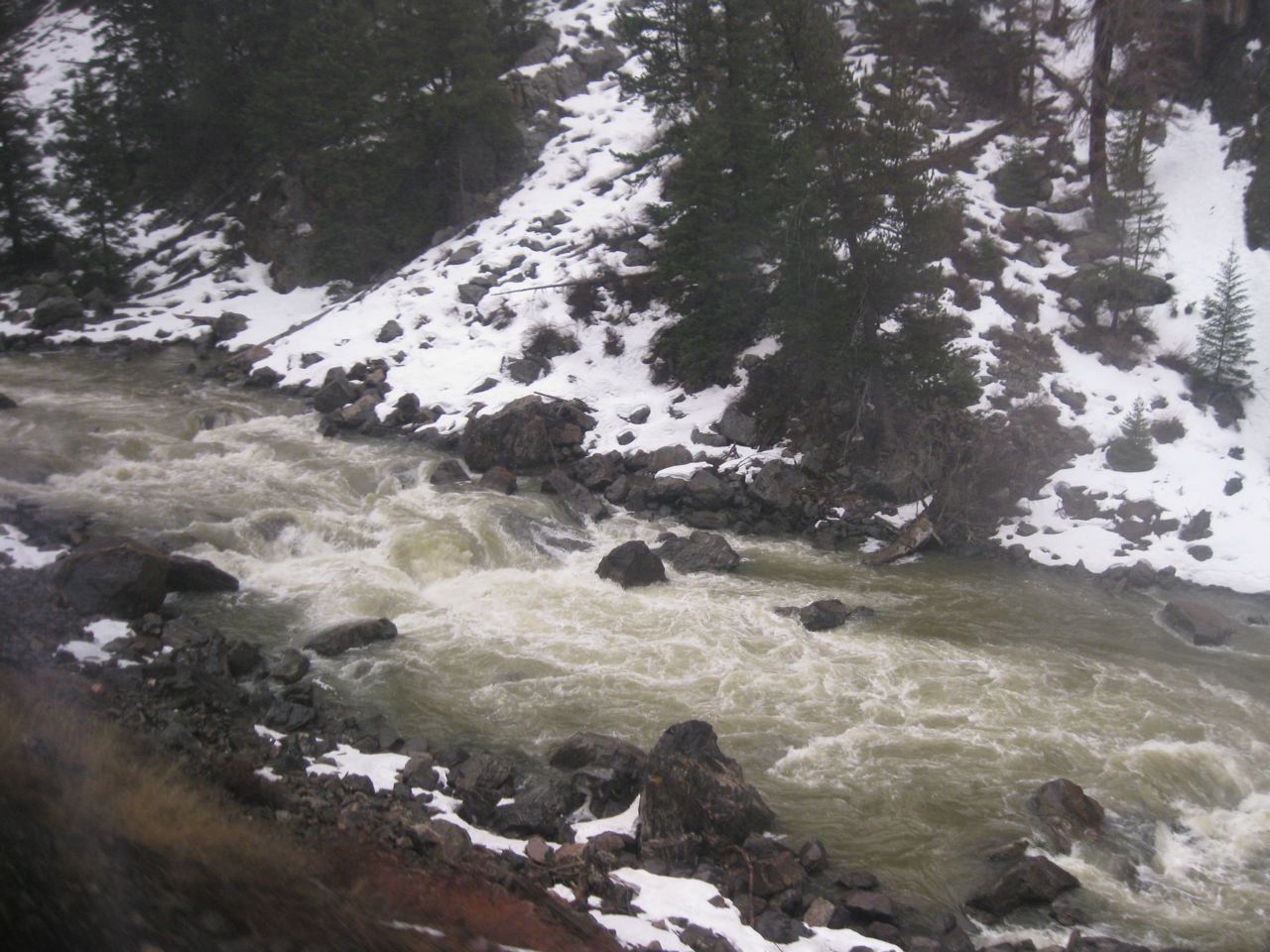 |
| Finally, at I think Gore, we met a UP freight, a westbound merchandiser with a single DPU on the rear. |
 |
 |
 |
| Then at the next siding was a westbound UP coal train, 6 units up front including two "patched" ex-C&NW 8800's, in the lead and as 6th unit, with one ex-SP in the middle. |
 |
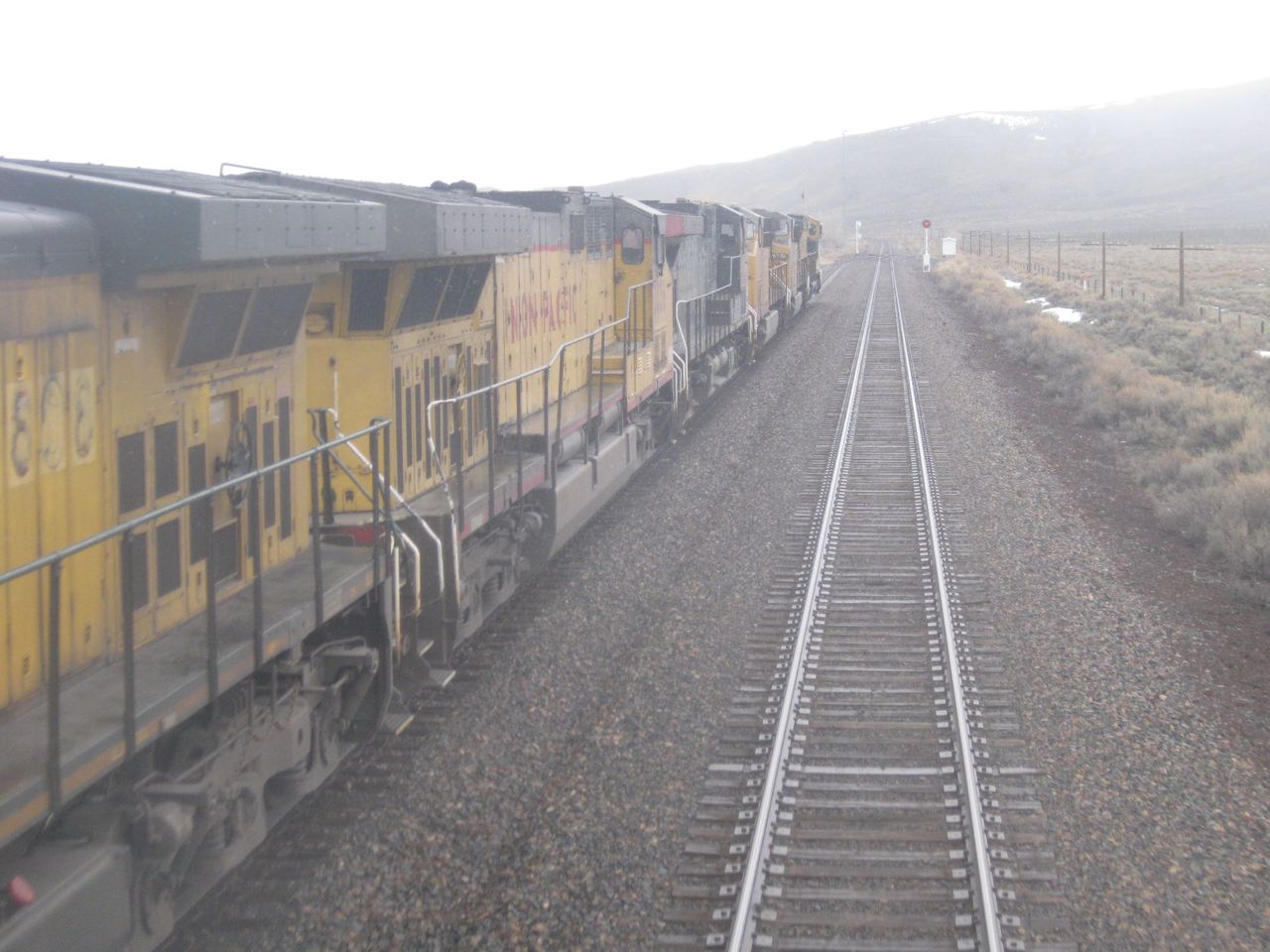 |
| Granby station stop was on-time, 3 minutes, out at 3:12, but the image is fuzzy through the rear window, sorry. |
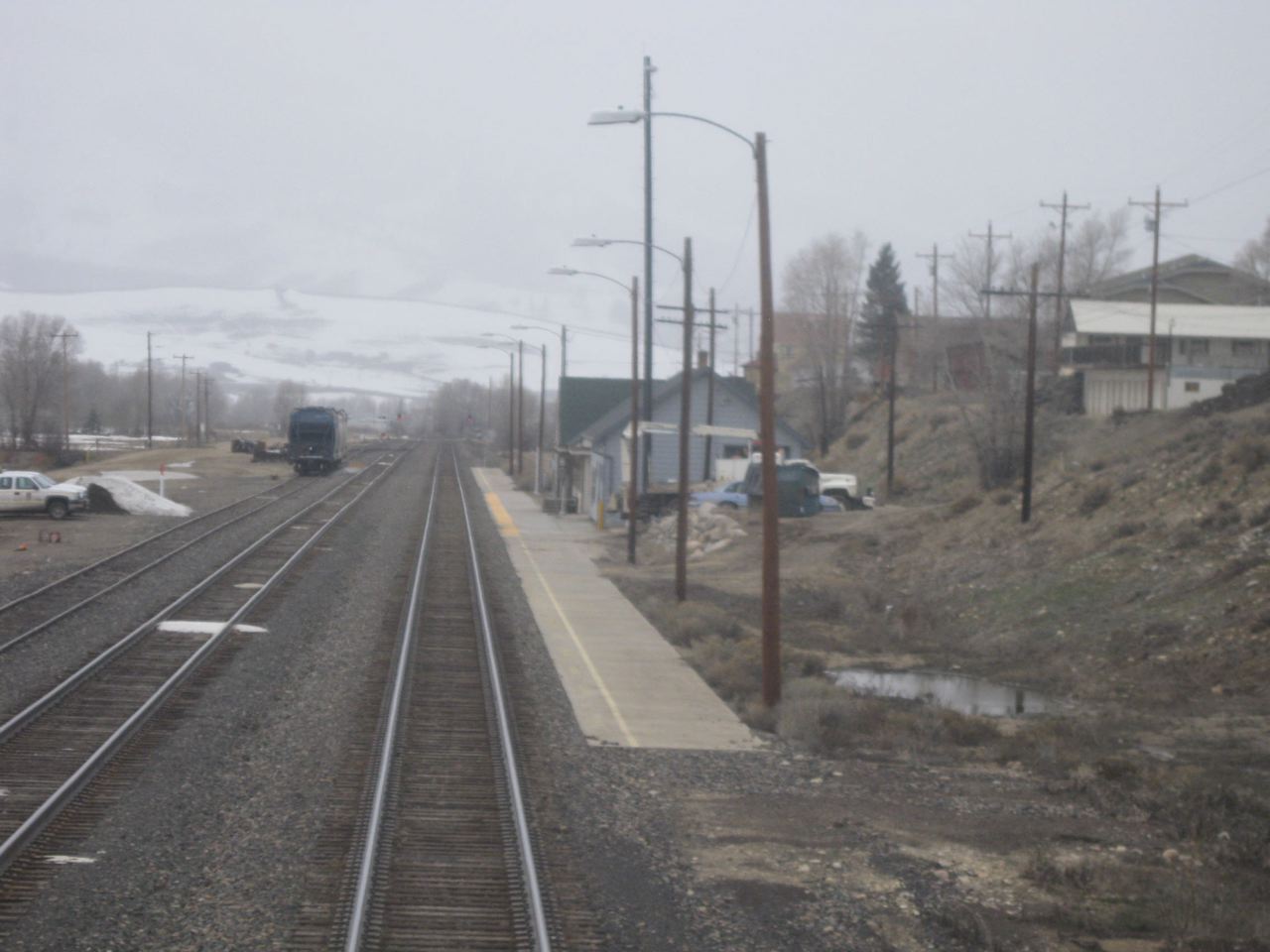 |
| I was on the phone to Wisconsin during our Fraser-Winter Park stop, 3:36-3:50, on-time departure, and we could briefly see the sun thru the clouds. The next photos are approaching and entering Moffat Tunnel, in at 4:03:48 and exiting at 4:13:04 pm. |
 |
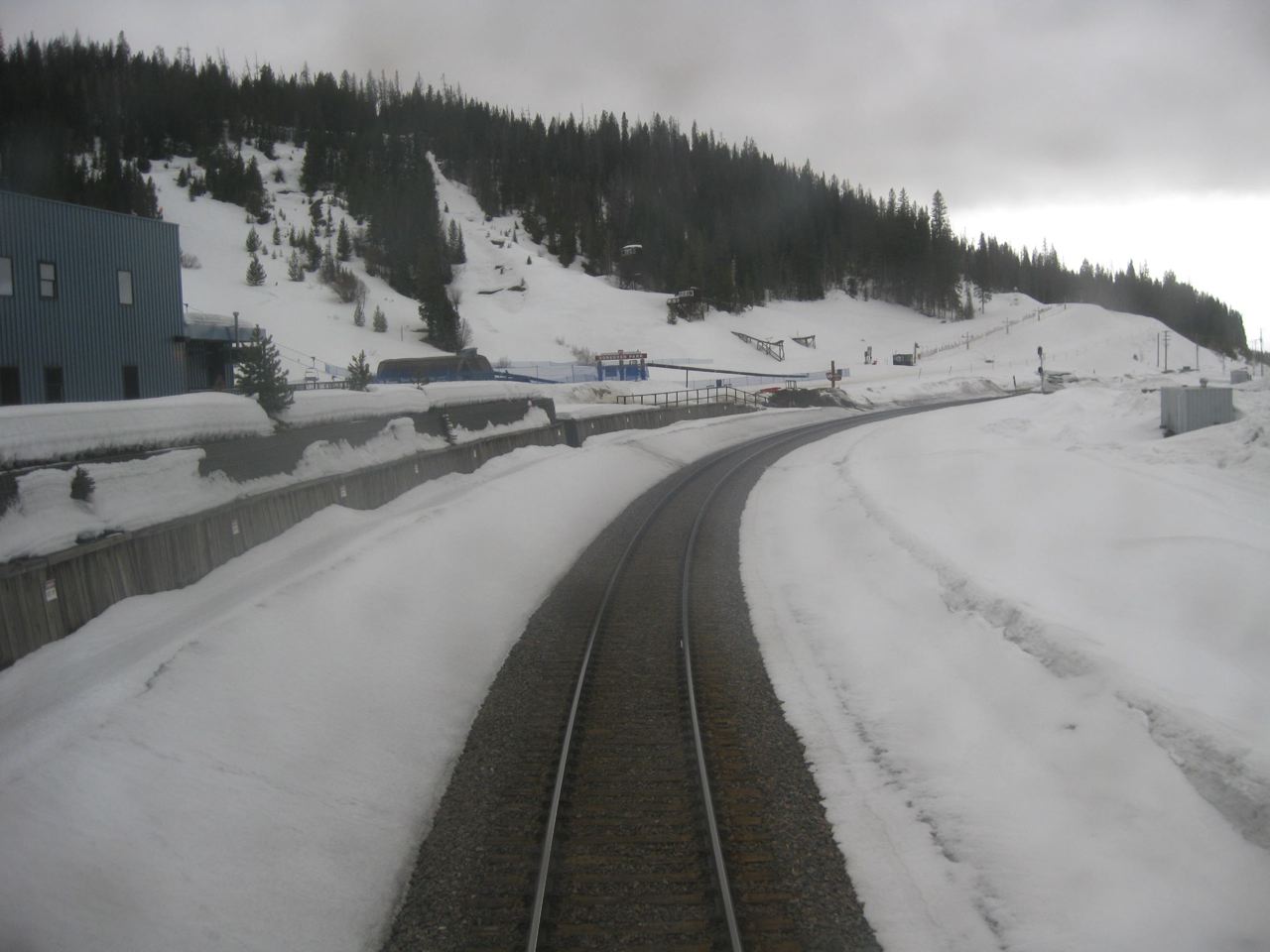 |
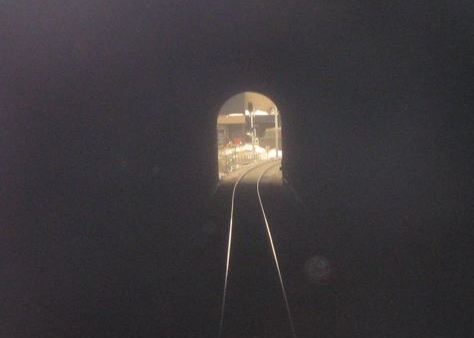 |
| We played two games of Rail Baron on the computer. First one, Rick won, JDI a close second, Chuck (who ran the game on his computer) a distant third. Then sometime during the 2nd game, Chuck, hit the wrong key and bought the wrong RR for Rick, which is an uncorrectable error in that program, so we accused Chuck, who was way back in 3rd place in RR ownership, of doing it on purpose (he didn't, of course, but what are friends for); Rick and I were about equal again in ownership, so a similar result to Game 1 was likely. Now we are descending the Front Range from Moffat Tunnel. |
 |
| A glimpse of the Great Plains near, of course, Plainview. |
 |
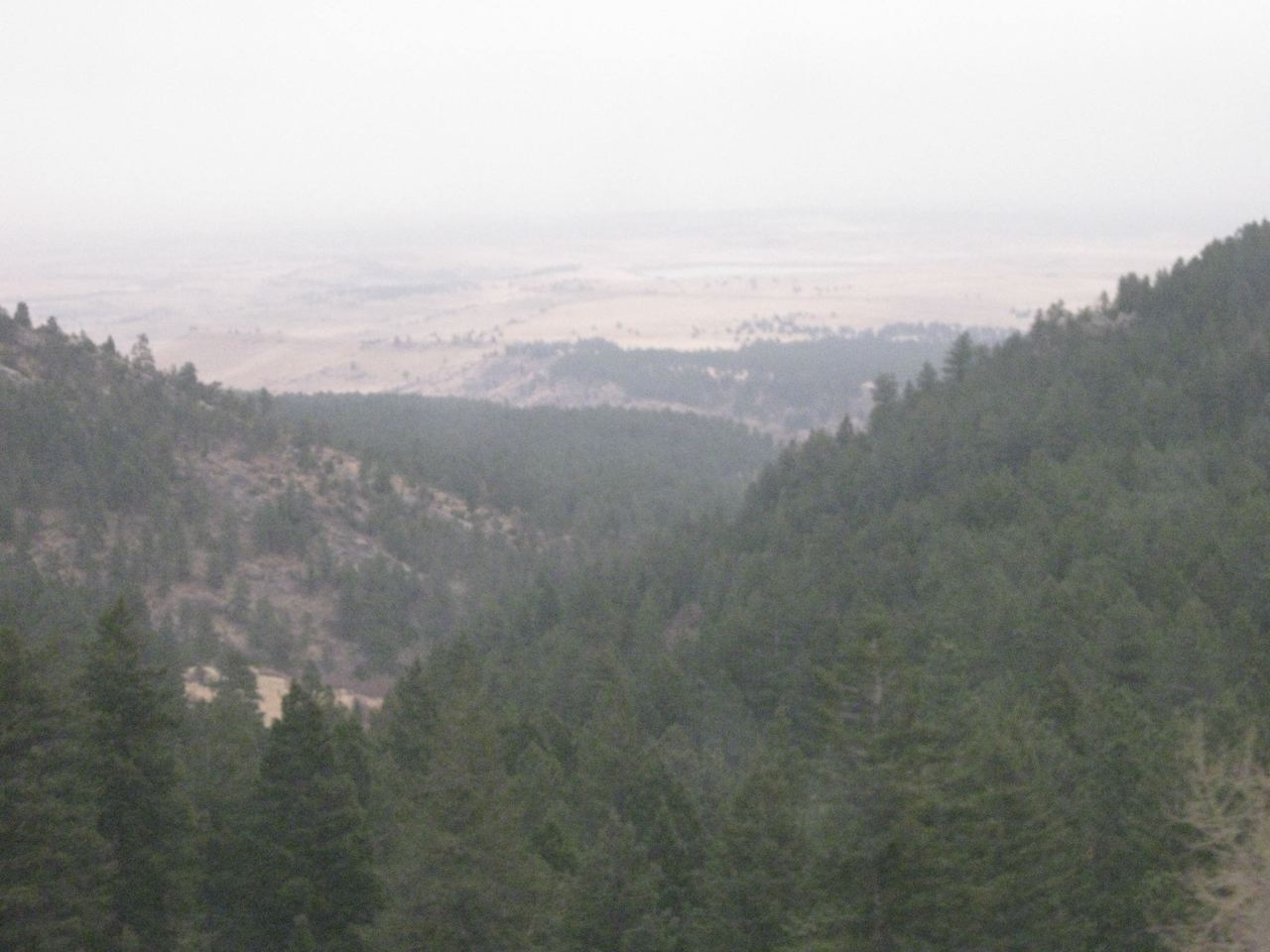 |
| Around the "Big Ten" loops. |
 |
| The Rocky Flats local waited to back out of its siding and follow us down into Denver. We've just come right to left across the middle of the photo on the downgrade and swung around the Big Ten Loops, out of the photo to the left. |
 |
| While Union Station undergoes a total rework of its old track and platform area, for light-rail, Amtrak, bus lanes, and who knows all what, Amtrak has a temporary new station across the street under the 20th Street overpass. A special platform and cover shed for the Zephyr, the only Amtrak train to serve Denver, has been built. Passengers walk across a street at a protected intersection to reach the depot. Our Denver dwell time was from 5:51 p.m. 47 minutes early, to departure at 7:11 pm, 1 minute late. We dined toward the end of that layover. |
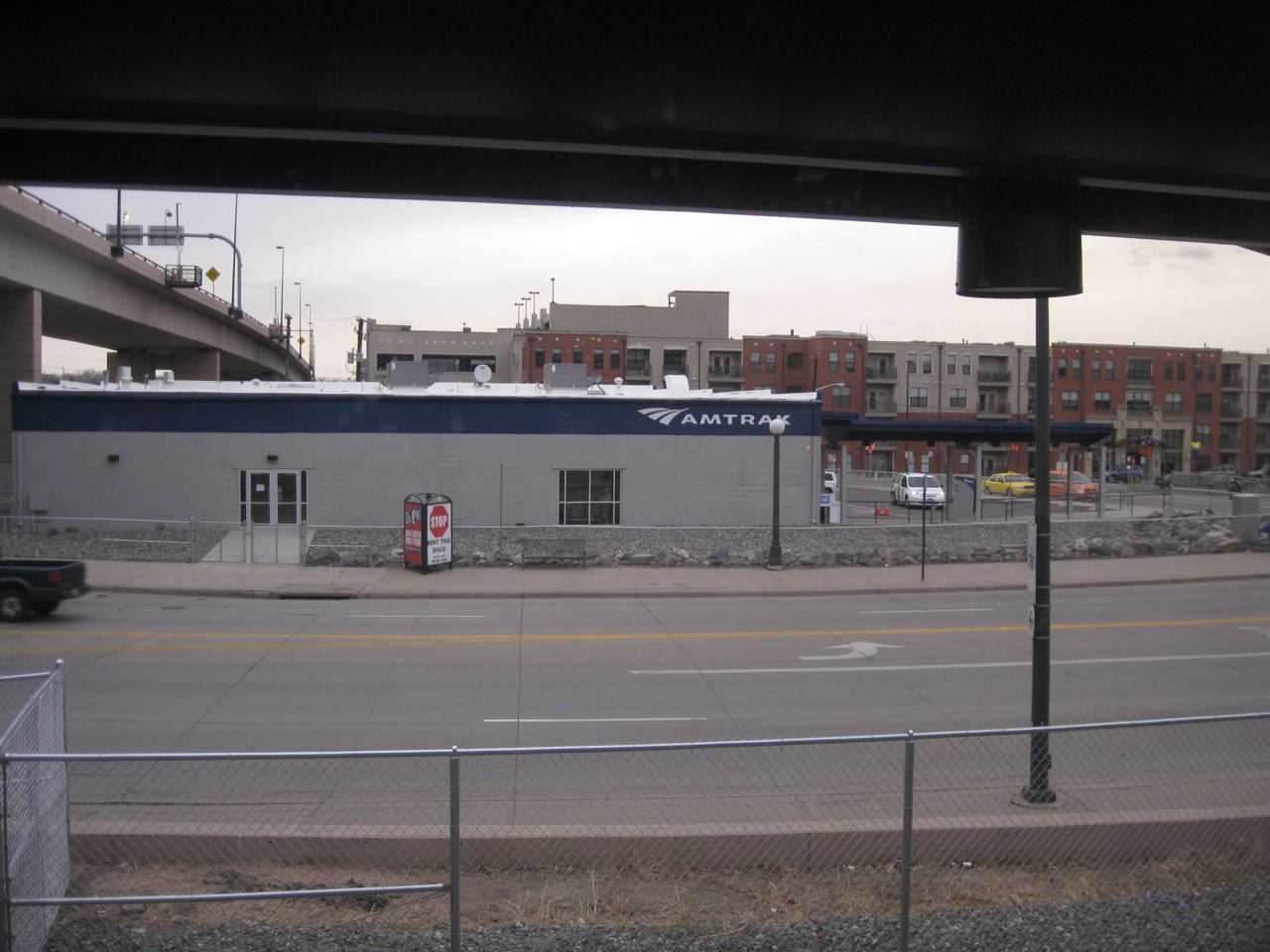 |
| The view from the rear of our train at the decimated track area of Union Station. |
 |
 |
 |
| The new lone platform is curved; the depot is at the left. It's expected to be in use for 2 or 3 years, maybe more! |
 |
| Walking up the sidewalk on the inclined street nets this view, just behind the left-field corner of the Colorado Rockies' Coors Field. |
 |
 |
 |
| Here is the depot; I didn't bother to check it out, others said nothing unusual about the smallish interior. ETTS for Union Station, that's for sure! |
 |
| On Thursday May 7th, the last day of the trip, I awakened out of Creston, Iowa, where we left 4 minutes late at 7:08 a.m. CDT. I was interested to see the progress on the spiffing up of the old CB&Q depot in Osceola, the first photo of the day, as we left 7 minutes down at 7:47 a.m. One victim is the traditional black wooden station signboards on each end of the depot, but like Princeton, Ill., the building looks very nice, and the parking lot was pretty full. Osceola is on I-35 south of Des Moines; we overnighted in Osceola en route home from California in Sept. 2009, our last overnight on the road on that trek. I photographed #6 stopping here in thick fog that morning, but only in slides, we'd filled up our memory card in the digital camera! |
 |
| At the IC&E crossing on the west side of Ottumwa, MP 281 from Chicago, we overtook this eastbound coal train. |
 |
| Ottumwa is a crew change/rest/smoke/leg-stretch stop. We departed after a 9-minute stop at 9:31, 22 minutes late. |
 |
| At the east end of Ottumwa, contract switch firm Burlington Junction had a Geep working. |
 |
| And just beyond Ottumwa yard, we passed a westbound merchandiser; this is mainly a coal route now. |
 |
| Where else but Iowa would you see this traffic waiting for the gates to go up?! This is Mt. Pleasant, a 5-minute stop with a 27-minute late departure at 10:21. |
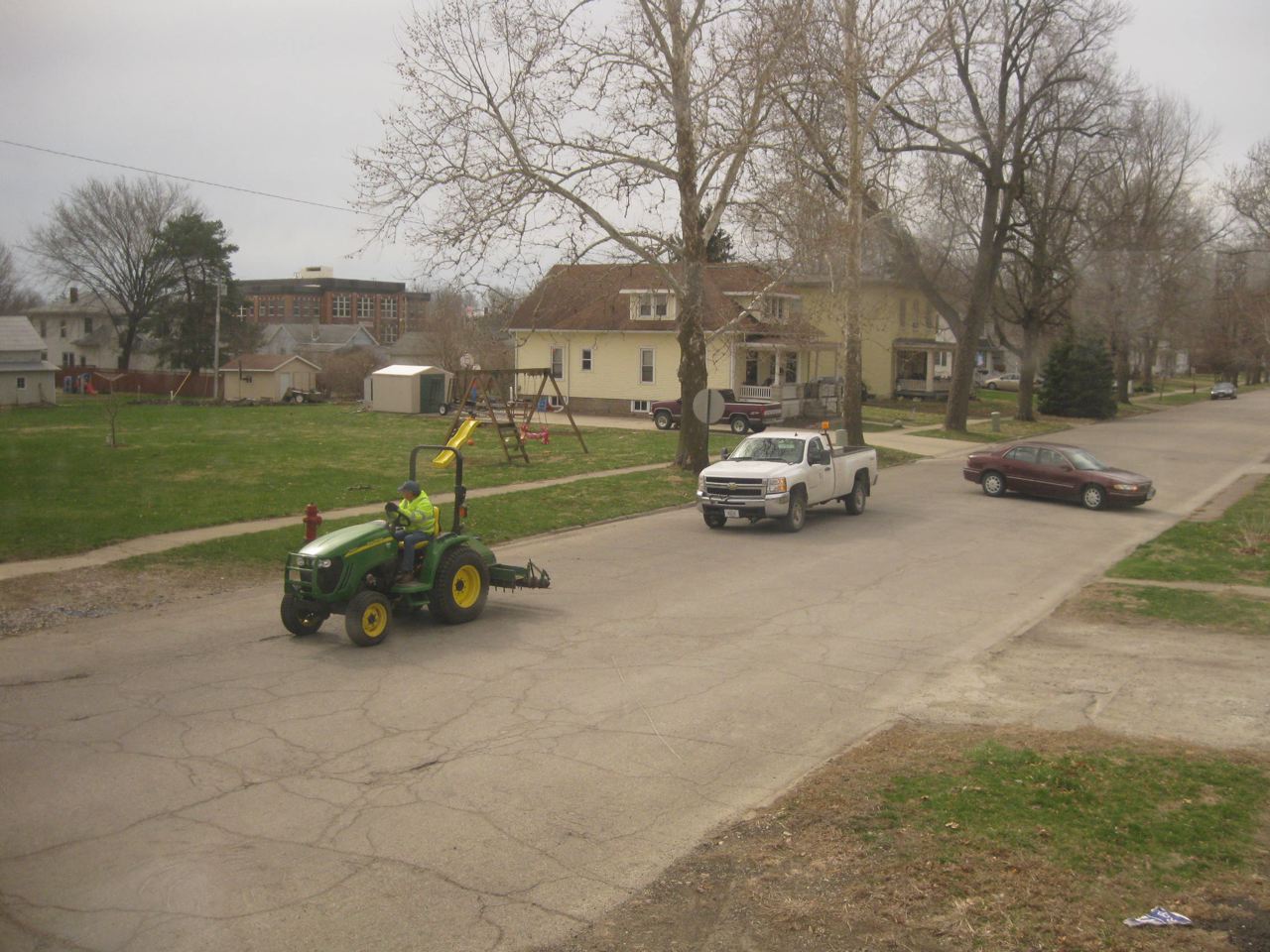 |
| Burlington and the 4-6-4 on display, 23 minutes late as we left at 10:59, and then activity in the yard. Still no sunlight today, either. |
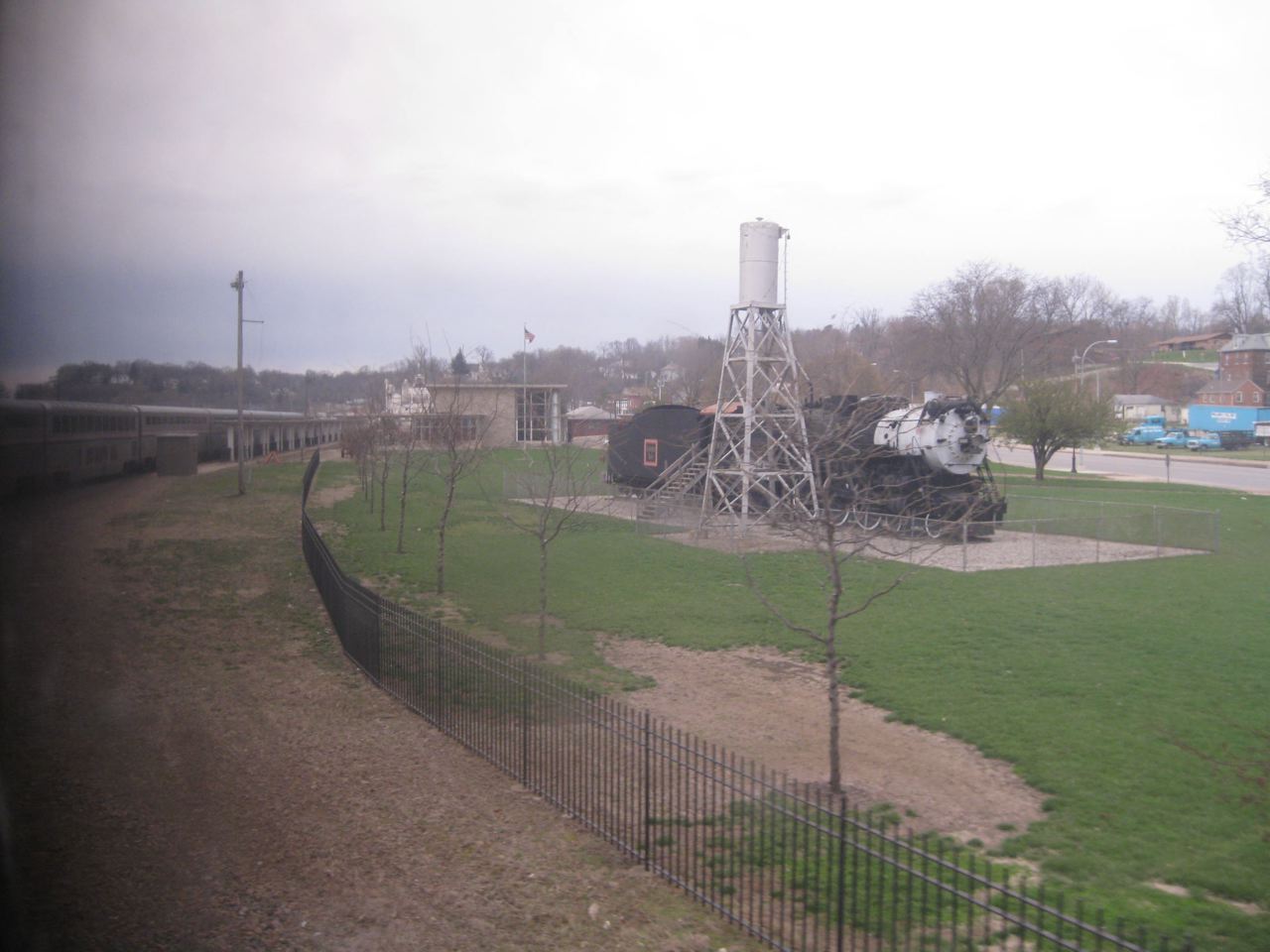 |
 |
 |
| The lift span on the Mississippi River bridge was just installed weeks before our trip. A set of power off the K Line along the river was at the switch. |
 |
 |
 |
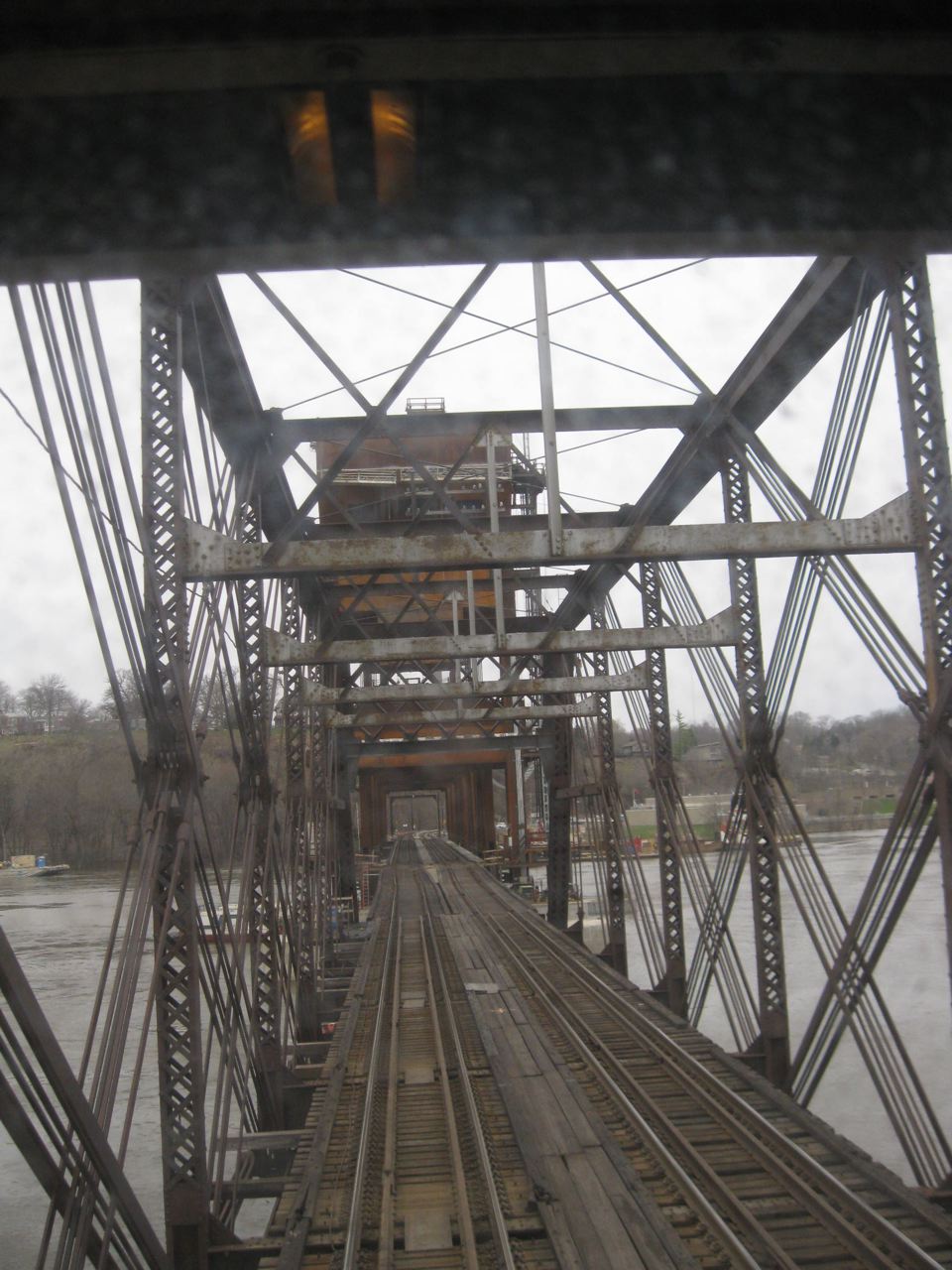 |
| Note the jog in the tracks between the old and new portions of the bridge. |
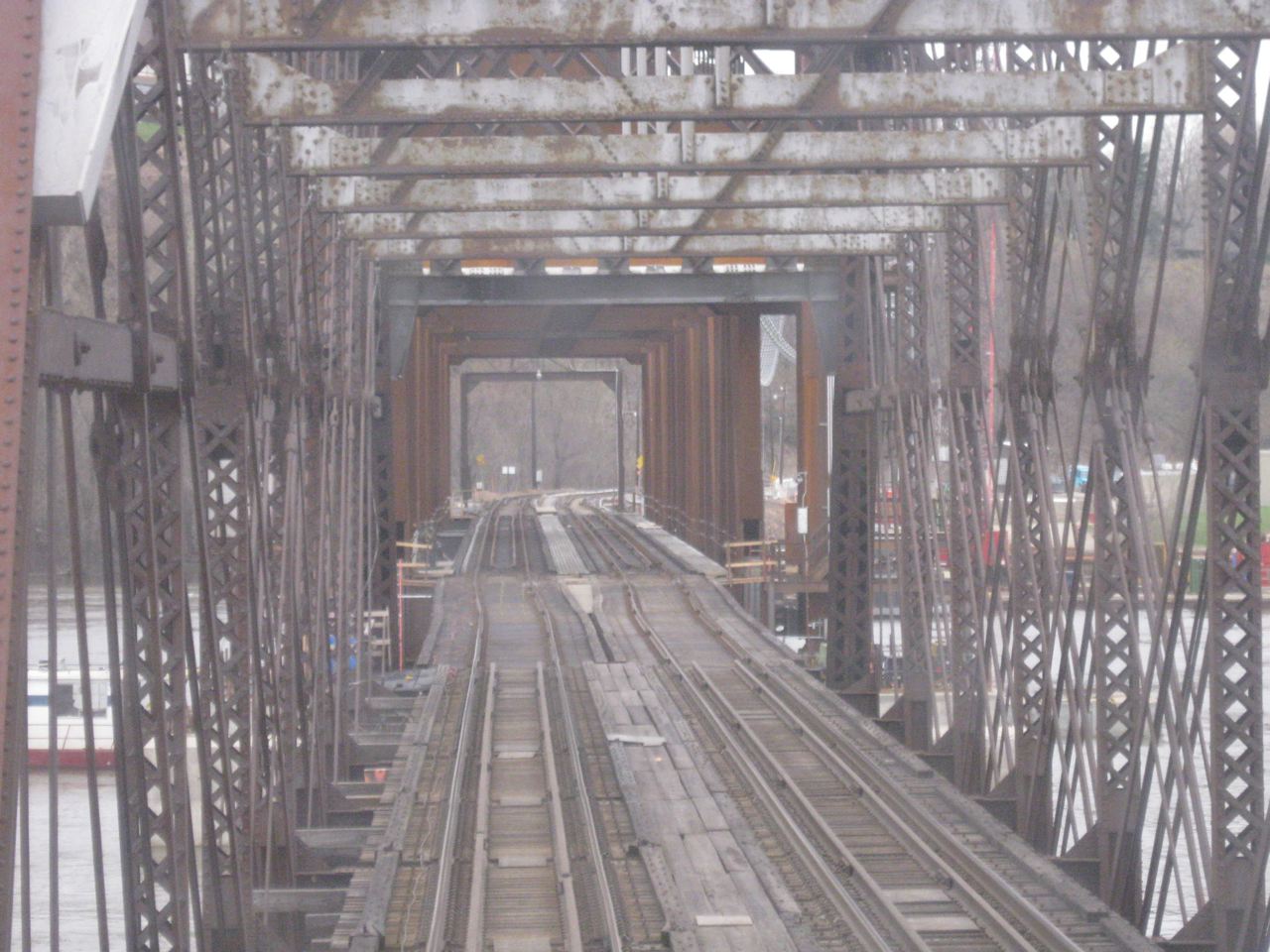 |
| The power off the K Line has moved into the yard. |
 |
| Span replacement machinery etc., is still on site. |
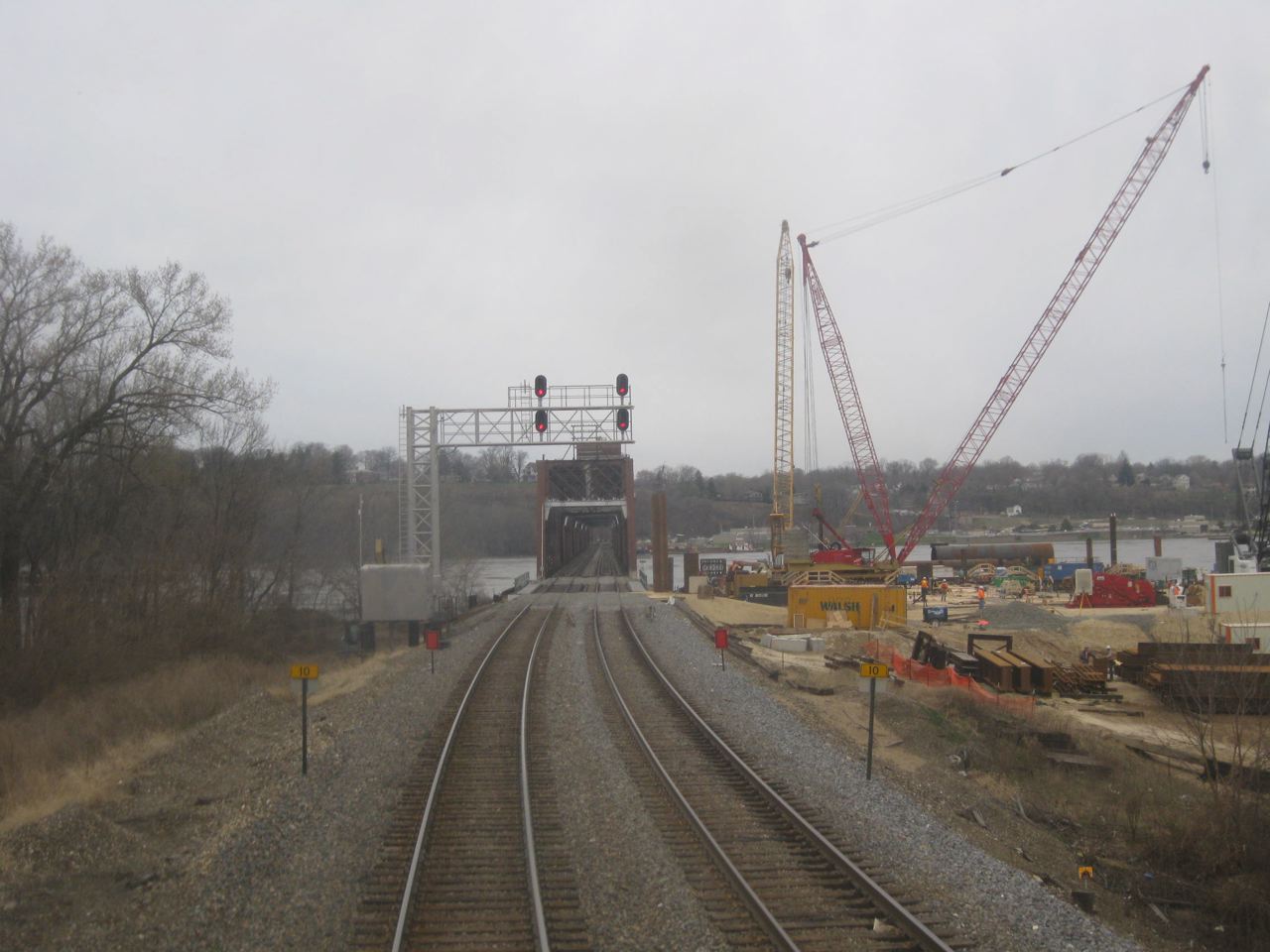 |
| Nearing Cameron, where we go under the former Santa Fe Transcon main, we passed the first of several staged eastbound coal trains. |
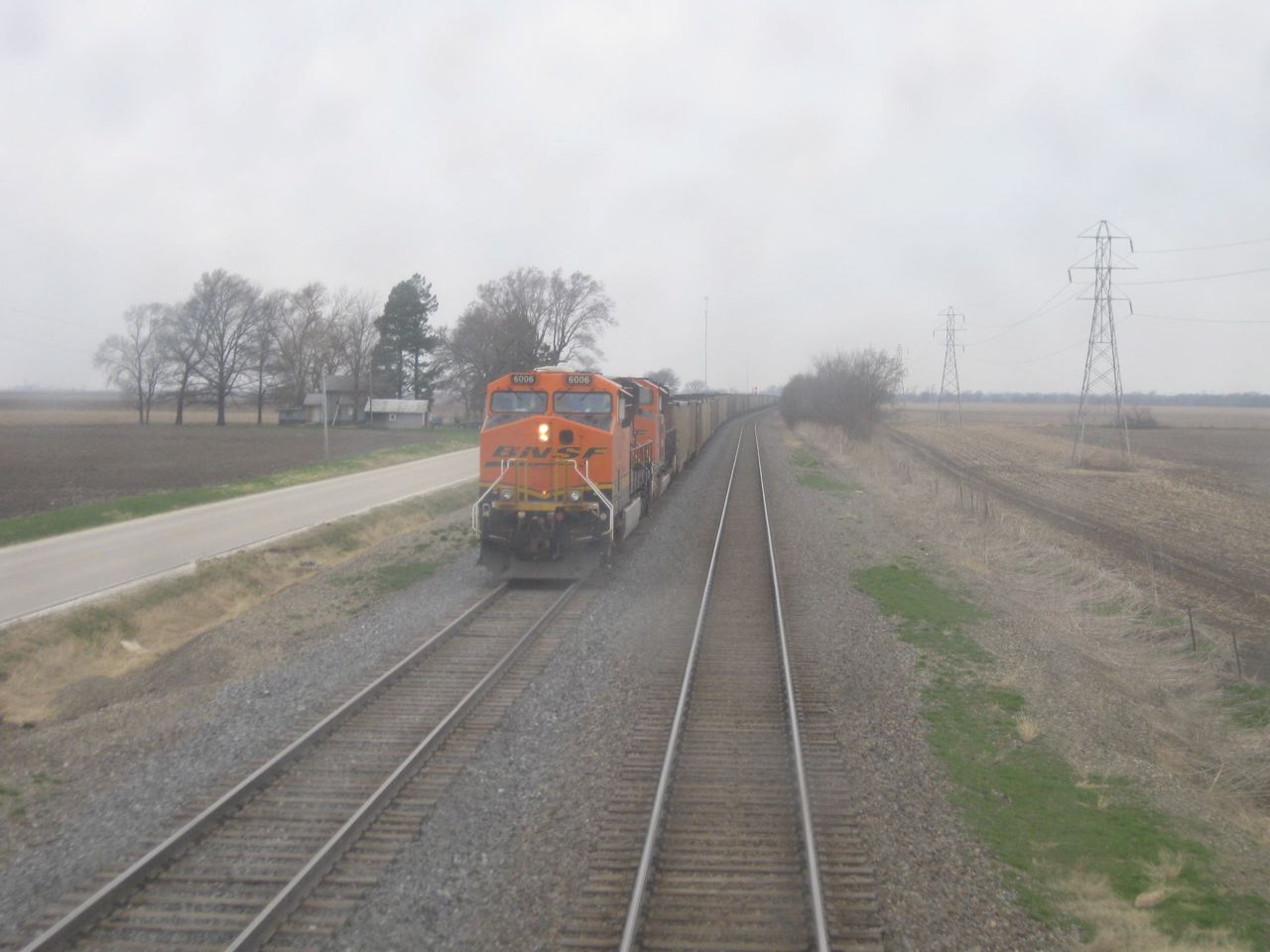 |
 |
 |
| This one waits at Graham, where the freight route to the south end of the big Galesburg yard, and a direct route to the line south from Galesburg, diverges. |
 |
 |
| After lunch out of Galesburg, I was back at the rear window as we went thru Mendota, at 1:05 p.m., passing this westbound coal empty. |
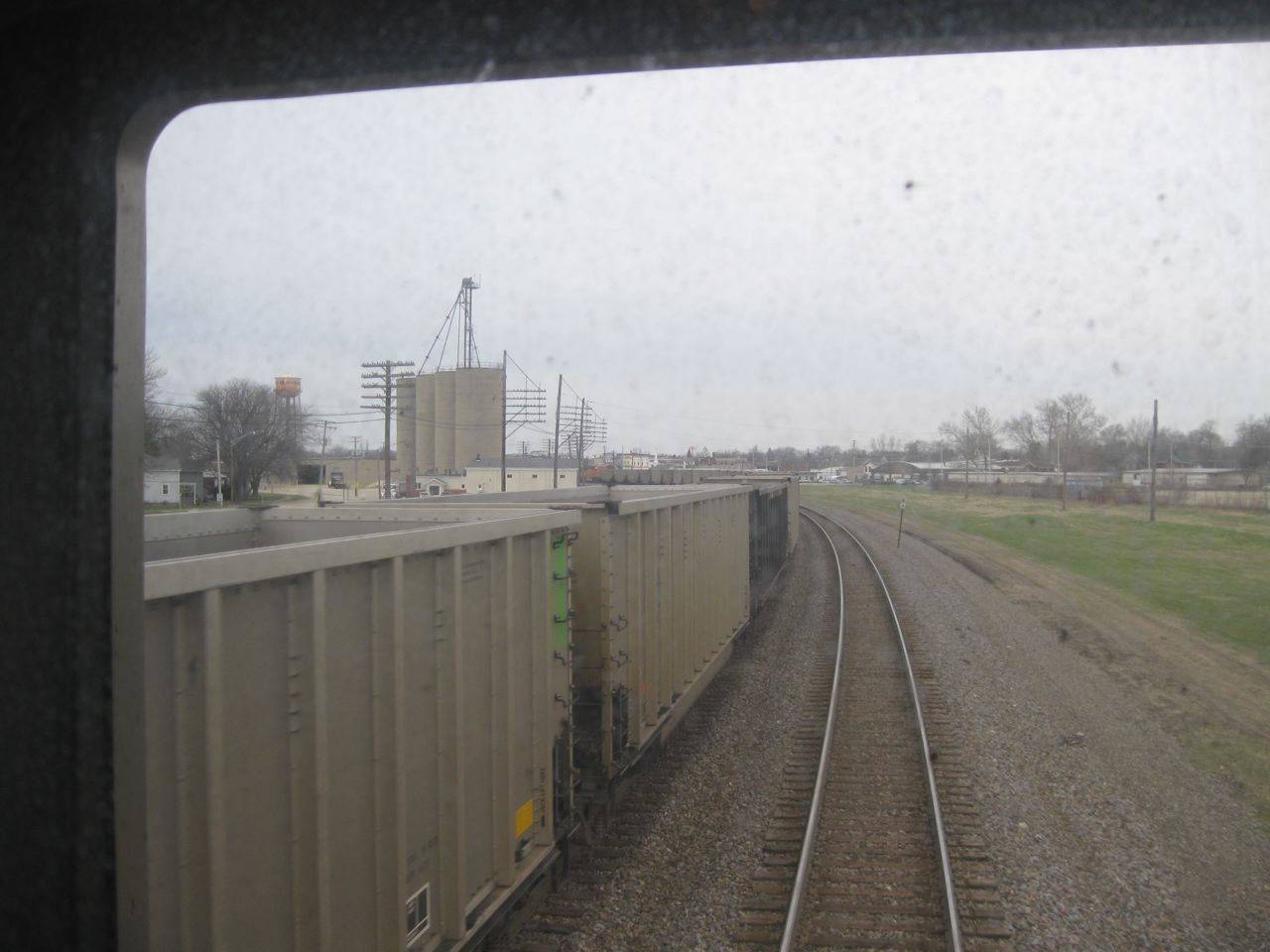 |
| First Avenue interlocking in Mendota, with some of the new signal bridges in place, concluded the photography. We arrived Chicago 22 minutes ahead of schedule, at 2:28 p.m., stunningly, allowing me more than a half hour to wait to board Hiawatha #337 at 3:15 for Milwaukee. I logged a total of just under 5,400 railroad miles on this California trip. If the signals on BNSF's Mendota Sub here interest you, check out the photo section on this Website for my visits in spring 2010, just before the replacement program started. -- JDI |
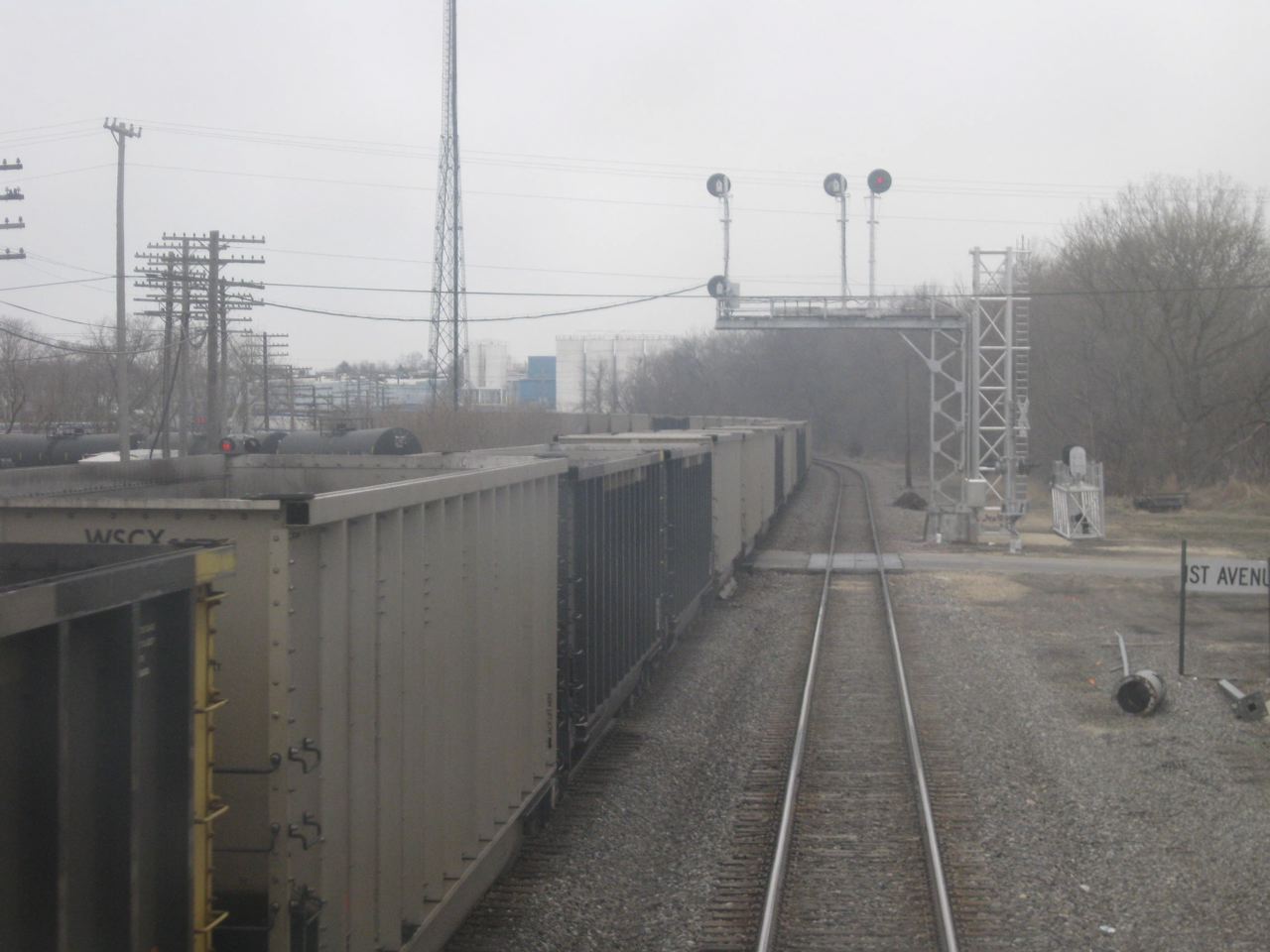 |
 |
This page was designed and is maintained by Mike Condren. If you have materials
that you would like to contribute, contact me at mcondren@cbu.edu

